Exactly What to Do in Portland, OR (for First Timers)
We love living in Portland for many reasons. The excellent food scene. The incredible green spaces within city limits. The easy access to jaw-dropping natural beauty.
We firmly believe that Portland is one of the best cities in the country for a quick getaway (there’s a reason we chose it as our forever home after a couple of years of being on the road full time).
It’s a big enough city that there’s plenty to do and see to keep you busy for a couple of days, but it’s not so big (looking at you, New York City) that it’s nearly impossible to even make a dent in. It only takes 15-20 minutes to drive from one side of the city to the other!
If we had to boil it down, Portland has a couple of things going for it that make it a really special place to explore.
First and foremost, it’s an incredible food city. There’s something about the culture of food carts – which are very prominent in Portland – that has created this unique atmosphere that is the perfect breeding ground for innovation (more on this in the guide below).
Second is the great green spaces within the city limits. In particular, we love Washington Park, which is near the top of the list of the best urban parks in the country (don’t worry, you’ll find it in the guide below!).
In this guide, we’re going to go through our absolute favorite things to do in Portland, including what to do, see, eat, and drink, all based on our own experiences living in and exploring the city.
We’ll cover everything from some of our favorite hikes, independent bookstores, food carts, and more.
Plus, along the way, you’ll get our thoughts on what NOT to do in Portland, like what doughnut spots are overrated (looking at you, Voodoo) and a better, less busy rose garden.
Chances are, if you’re only here for a few days, you’re not going to be able to check everything off of this list.
To help you maximize your time, we have other guides (like our three day Portland itinerary) that put this all together in a logical way that has you seeing the highlights in your limited time.
We hope you discover something new to see, eat, or drink in this guide and that, ultimately, you fall in love with Portland just like we have.
Sound good to you? Let’s get into it.
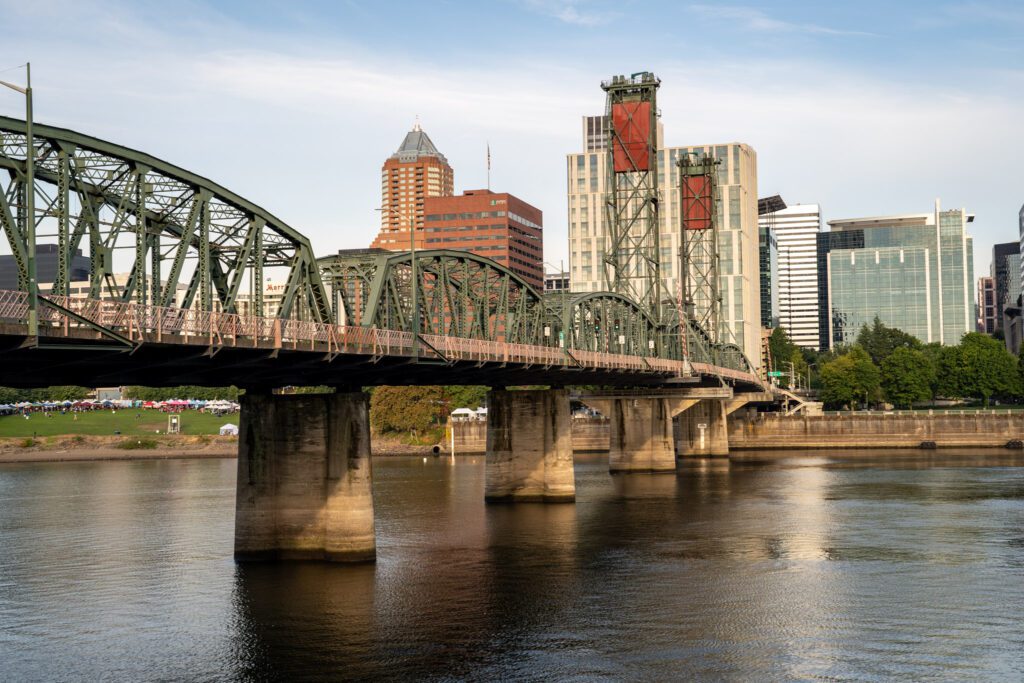
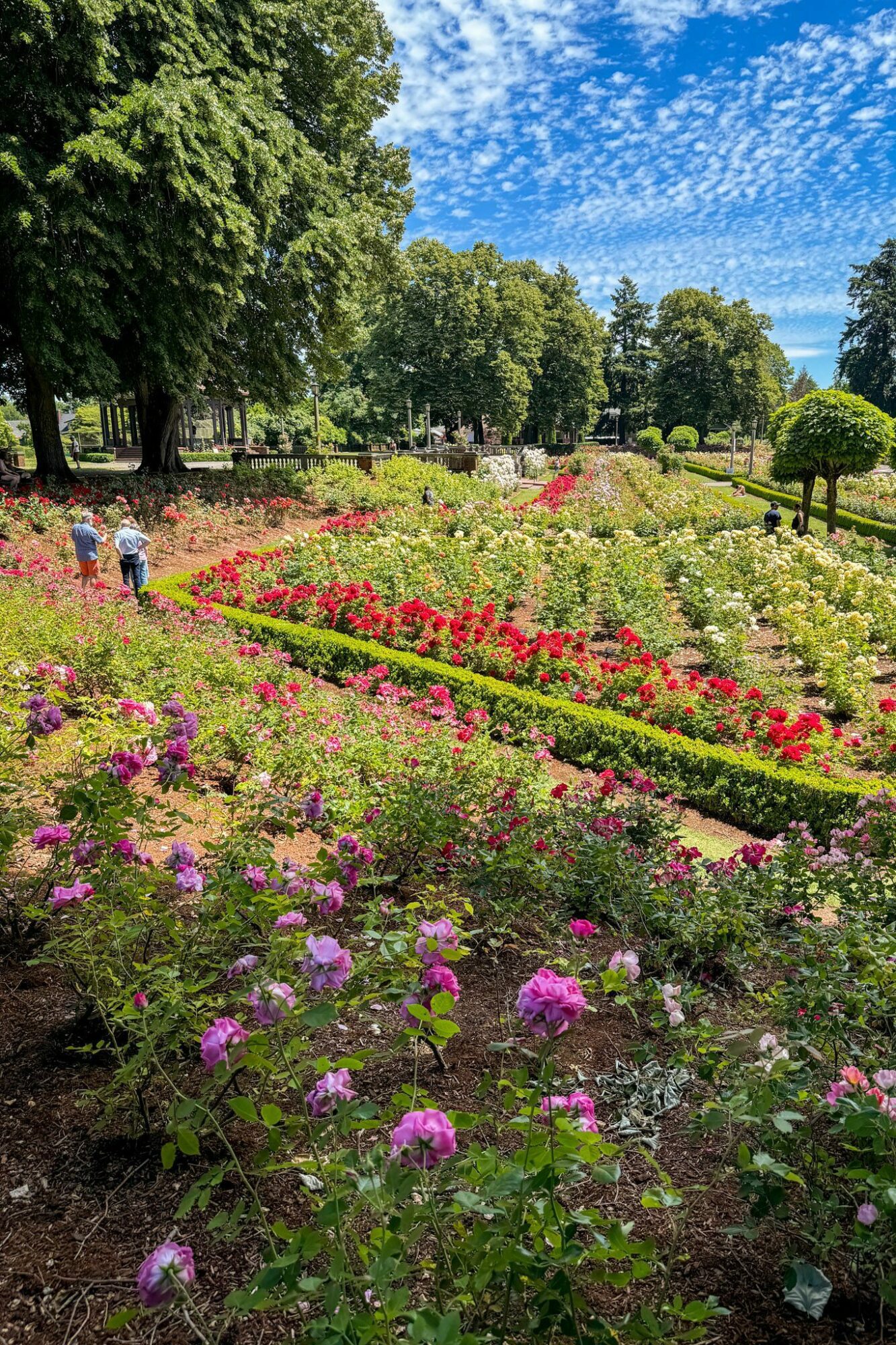
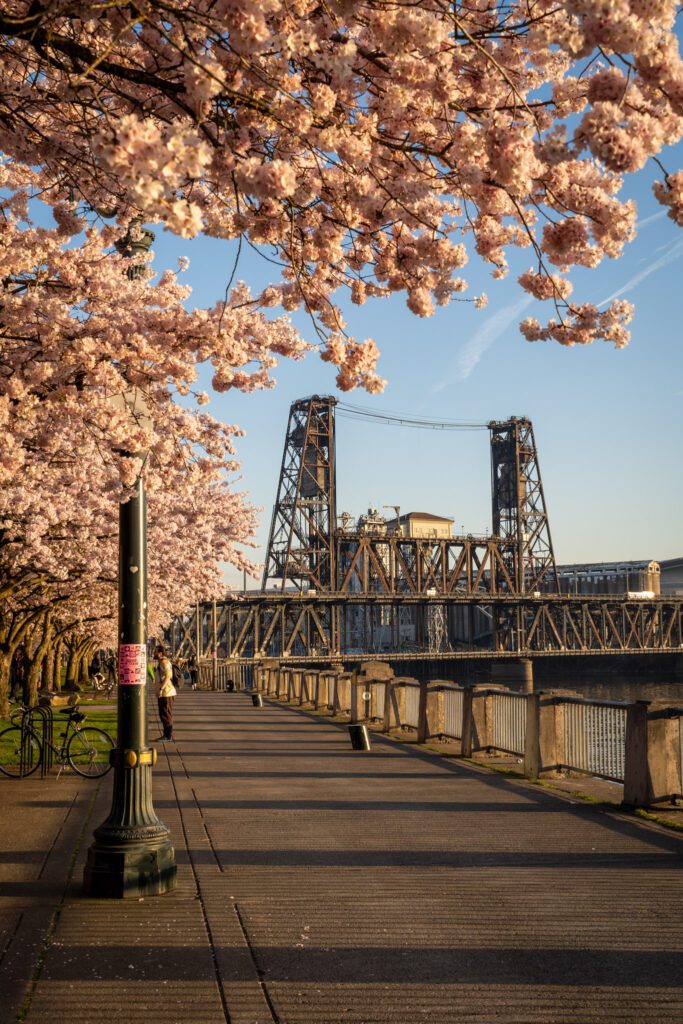
Disclaimer: Some of the links in this post, like hotel links, are affiliate links, meaning at no additional cost to you, we make a little bit of money if you click through and book. That being said, we would never recommend something to you that we don’t stand behind 100%.
Browse the Shelves at Powell’s Books
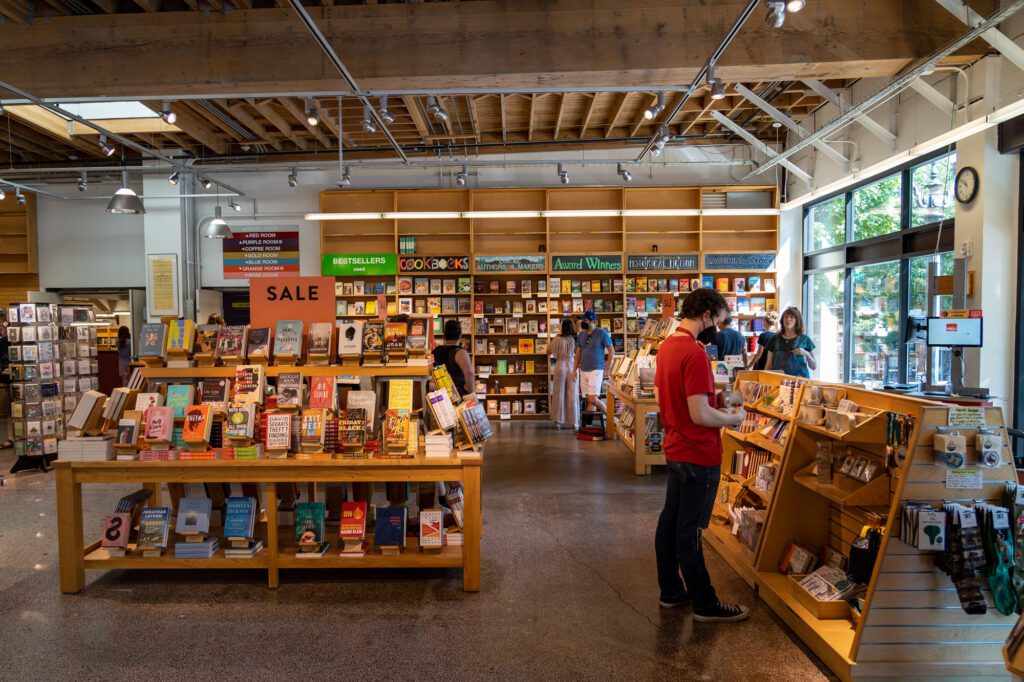
It says a lot about Portland as a city that our top recommendation on this list is not some museum or big tourist attraction, like the Space Needle in Seattle or the Golden Gate Bridge in San Francisco, but an independent bookstore.
When people visit us here in Portland, Powell’s City of Books is almost always on the list of must-visit places whether they’ve been there before or not.
Powell’s has two locations in Portland – one in downtown Portland, one on Hawthorne Boulevard in Southeast Portland – and our STRONG recommendation is to go to the downtown location because it’s a massive collection of books spanning just about every genre you can possibly imagine.
The location on SE Hawthorne is much more compact, but it’s also generally less busy (and it’s walkable from our house, which is why we end up there fairly often).
It is physically impossible for Matt to walk into Powell’s and walk out without at least one new book in tow.
Explore the Wonders of Washington Park (The Rose Garden)
Washington Park is an incredible green space right in the heart of Portland.
There are three things we think you should focus on here – the International Rose Test Garden, the Portland Japanese Garden, and Hoyt Arboretum – and we found a perfect route through the park that takes you to all three of them, along with some extra surprises.
We set out bright and early on a Sunday morning, starting from the Rose Garden and tackled the five mile loop clockwise.
It’s a relatively easy hike, though there is definitely going to be some up and down as you traverse some of the gullies in the hills to the west of Portland.
There are a few different options for where to start this hike and how to get there.
First is driving yourself, and we’ve got two parking options for you.
The best paid parking is near the International Rose Test Garden (or more specifically, the tennis courts up the hill – here on Google Maps), which we liked because you go uphill first, then finish with the downhill (does anyone actually like doing downhill first, and having to slog uphill to finish?).
You can pay at one of the machines (you’ll need your spot number!), or you can use Portland’s official parking app, Parking Kitty.
The second option is completely free, and it’s parking on SW Fairview Blvd (here on Google Maps). This is where the locals park!
If you don’t have a car, you can either walk up the hill from the Northwest District to the International Rose Test Garden, or take the MAX Line from Downtown to the Oregon Zoo.
Here’s a deeper look at our favorite stops in Washington Park.
The International Rose Test Garden
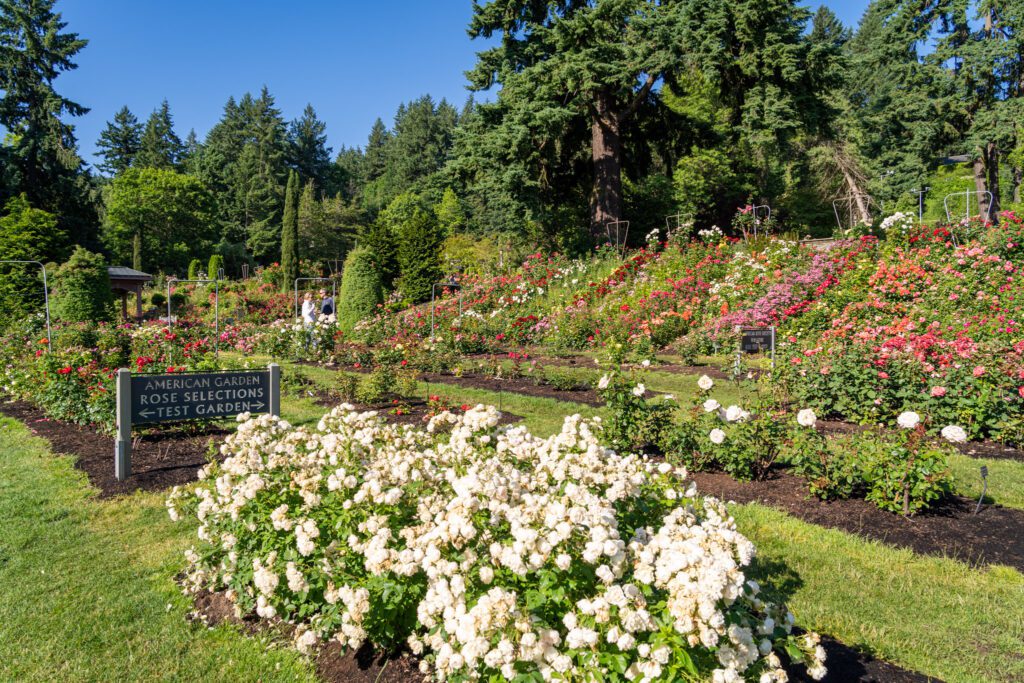
If you took our advice on the hike through Washington Park, you’ll be in for a rose-scented treat if you’re in town between June and October (ish).
The International Rose Test Garden is perched on a hill overlooking downtown Portland (and Mount Hood!), and has a truly staggering display of roses.
Portland, after all, is the City of Roses, and this garden delivers on that moniker in spades. Plus, it’s completely free!
Even if you don’t do the full loop, it is absolutely worth making a trip up here just for the roses (provided you’re here between June and October, roughly).
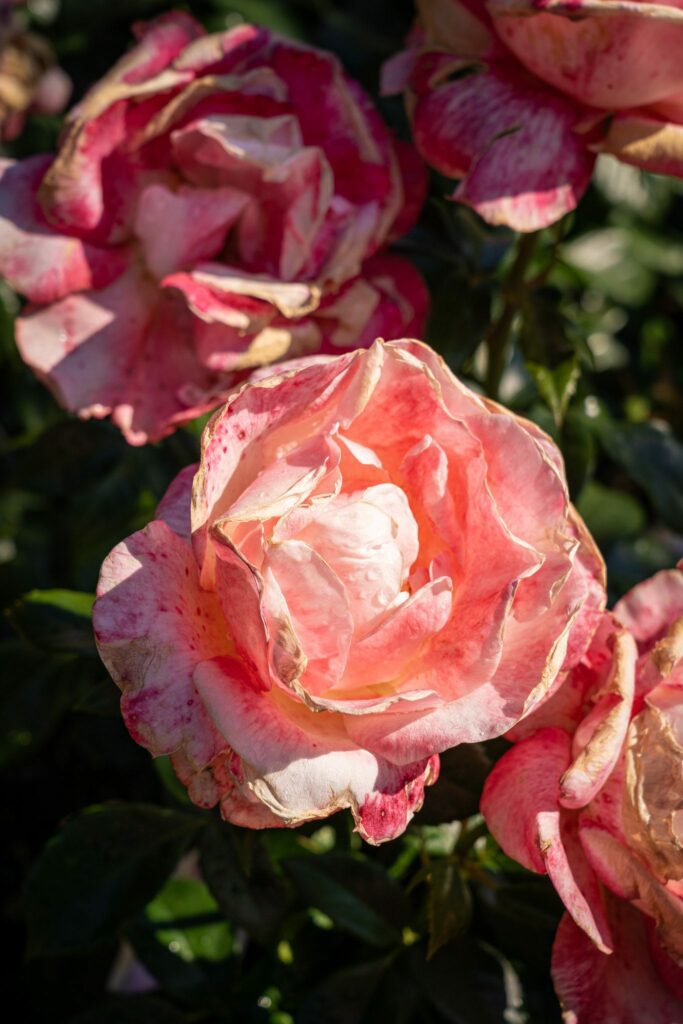
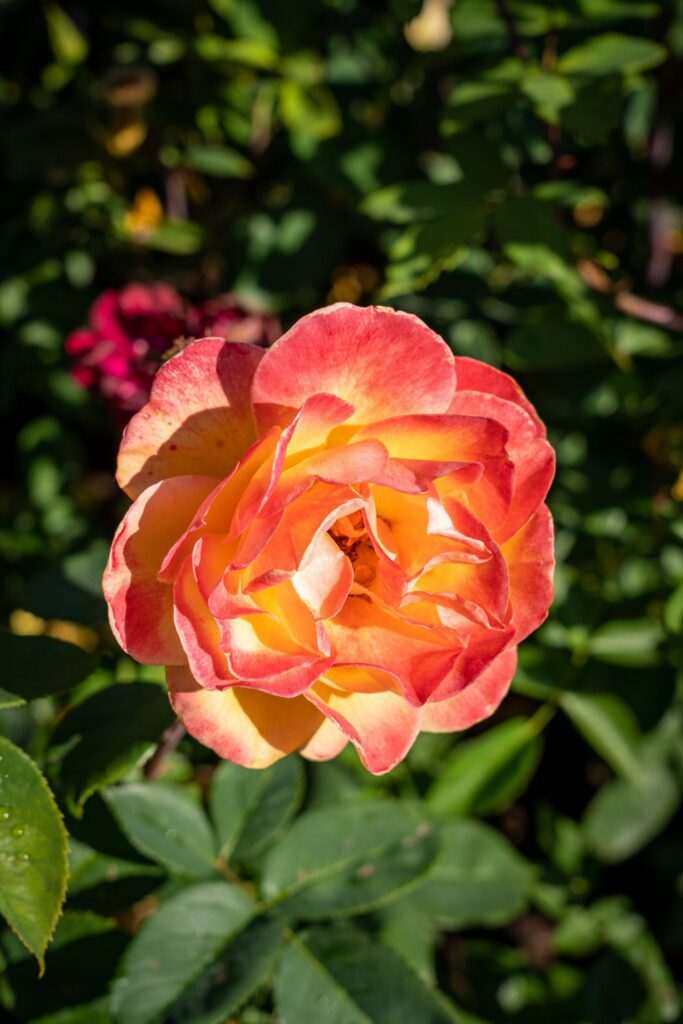
The amount of work it must take to maintain this garden and keep an inventory of everything that’s going on is very, very high.
There are more than 10,000 roses that call this garden home, of all shapes, sizes, and colors.
It’s the country’s biggest rose test garden, and it’s well worth spending some time wandering between the rose bushes and literally stopping and smelling the roses.
The Hoyt Arboretum
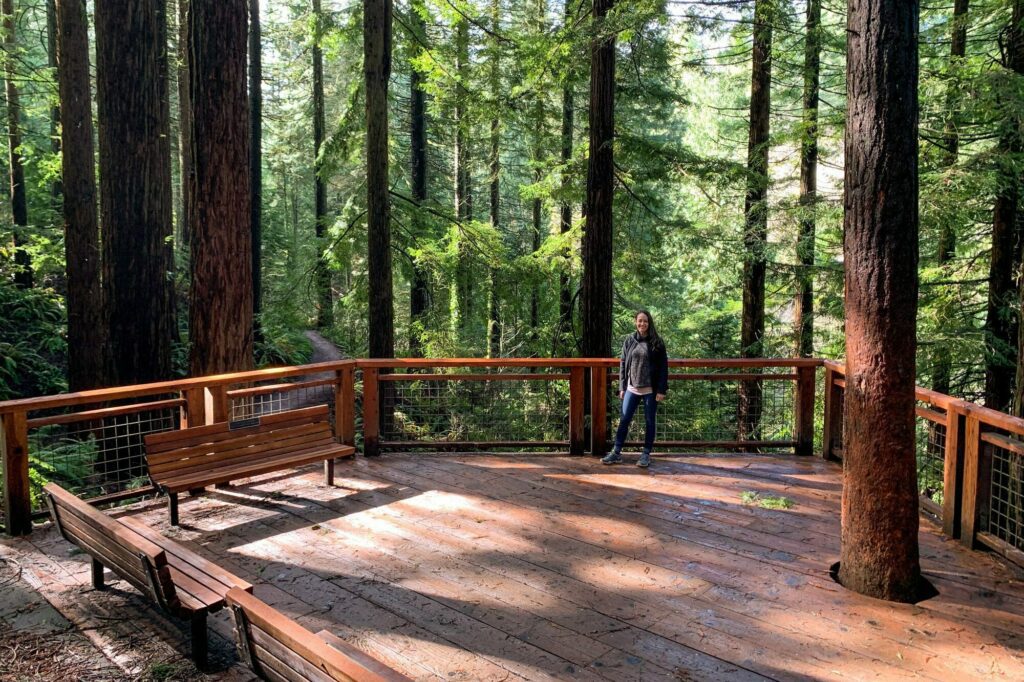
The Hoyt Arboretum is a fun aspect of Washington Park that often gets overlooked for the Rose Garden and zoo, but we really enjoy the Arboretum (plus, it’s also free!).
What is the Hoyt Arboretum, you ask? Well, in their words, it’s like a museum for trees.
They have 2,300 trees from all over the world (six continents are represented), near and far (California and New Zealand, for example). All sorts of magnolias, maples, redwoods, and native conifers that offer a little something in every season.
There is a robust network of trails, and they’ve organized a couple of different walks / hikes through the arboretum that you can follow, depending on what you’re looking for.
The Portland Japanese Garden
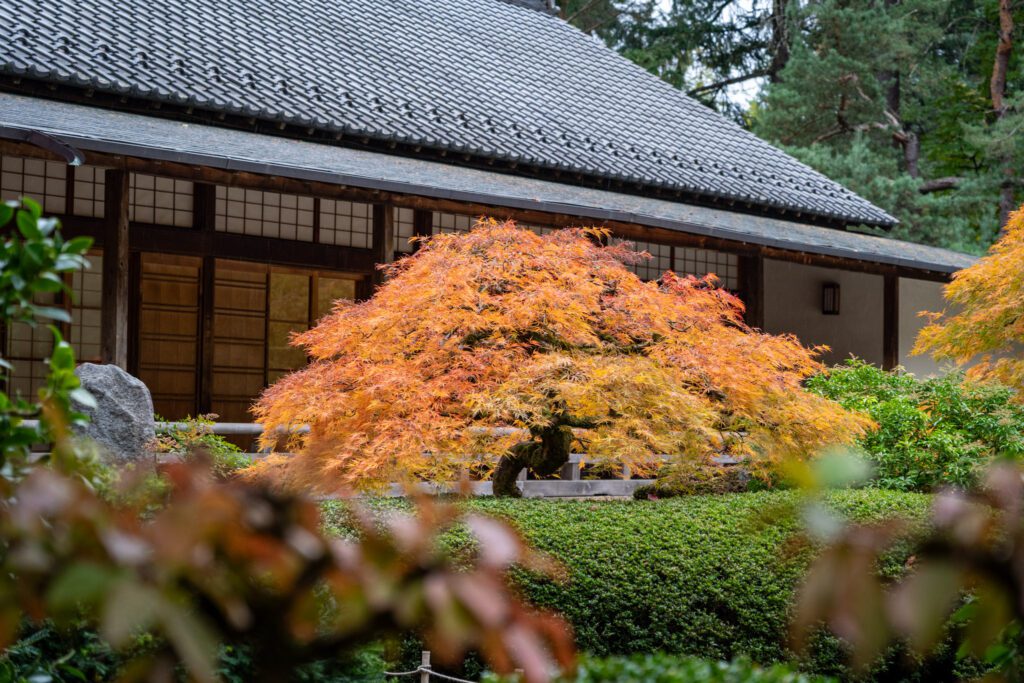
We love the Portland Japanese Garden, and are card-carrying annual members.The biggest benefit of membership is the early entry starting at 8am, before the garden opens for the general public at 10am.
The garden is at its peak in the spring, when the cherry blossoms are blooming (they bloom a week or two later than the ones on the waterfront) and in the fall, when the Japanese Maples turn the garden into a sea of yellow, orange, and red (we love the fall here!).
It’s a relatively small space, and you can cover it in about an hour if you take your time.
There are often exhibits on display that highlight art or cultural elements that are always worth popping into if they’re open.
There’s also an onsite cafe – Umami Café – where you can have tea and Japanese-inspired snacks.
Make a reservation if you can, because it’s a relatively small space and it does get busy.
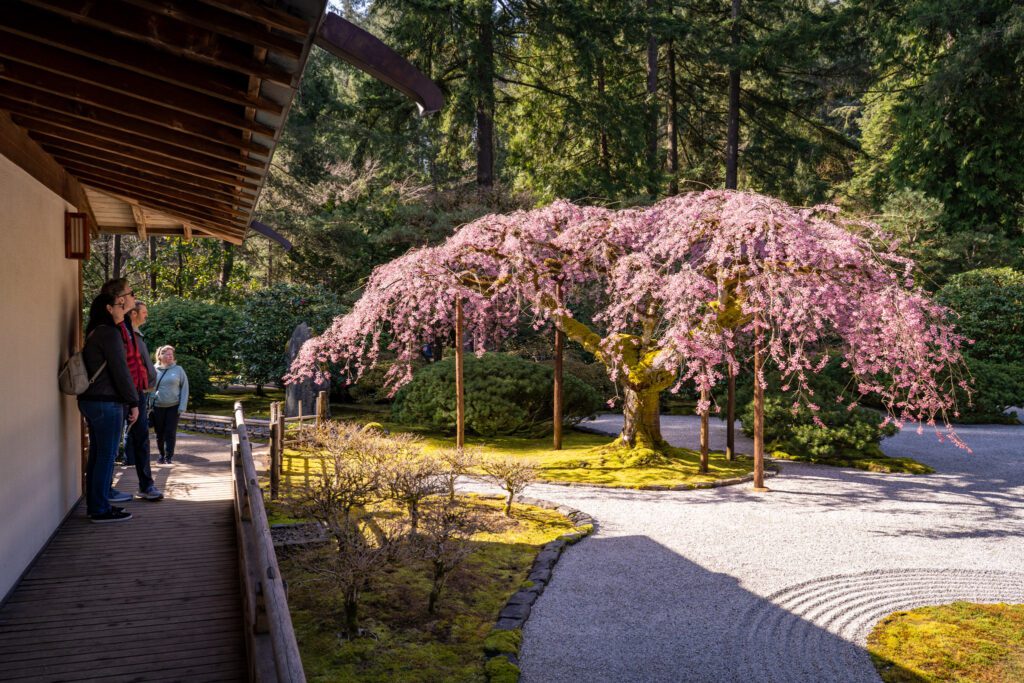
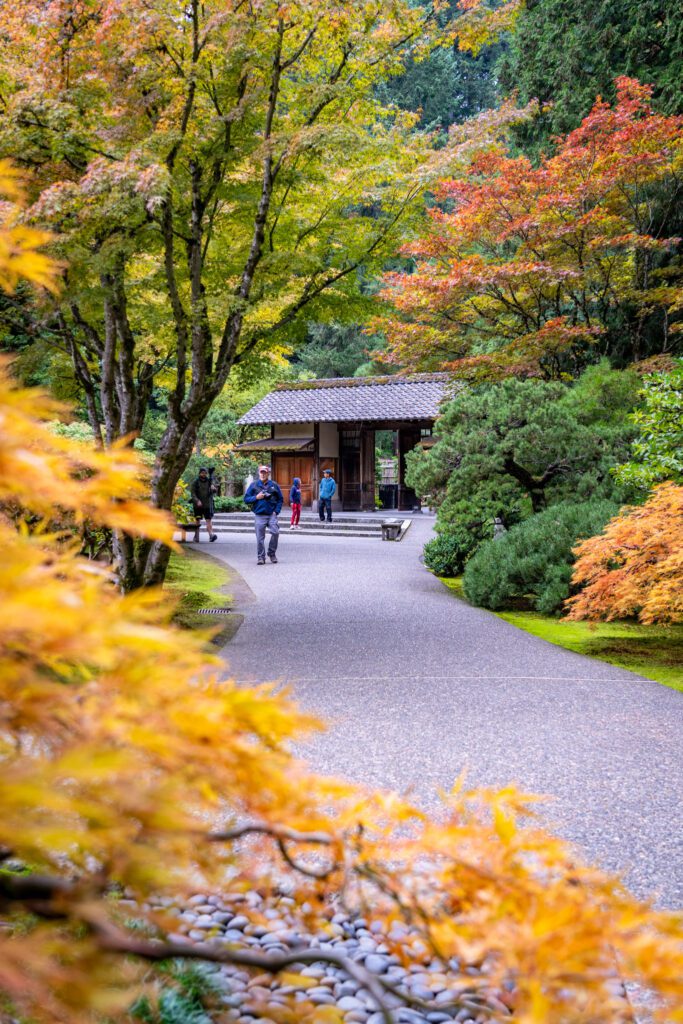
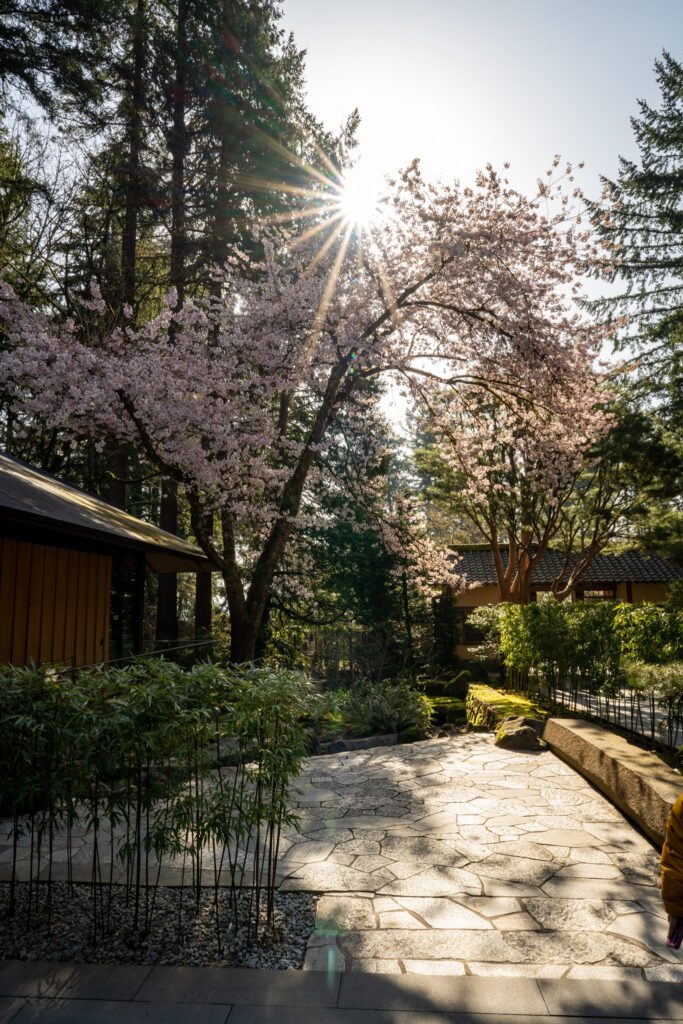
The Oregon Zoo
So we’ve never actually been to the Oregon Zoo, but we know a lot of people love it (especially people with kids).
We’ve always found zoos a little depressing (elephants probably don’t belong in the Pacific Northwest, if we’re being honest), but they do have a collection of native PNW species – including condors and mountain goats – that are a fun way to foster an appreciation of wildlife in kids.
They also have seasonal events like Zoo Brew – a beer festival at the zoo – and Zoo Lights – a winter light display – that we’ve been meaning to make it to. You can find their events calendar here.
Eat at a Food Cart AT LEAST Once
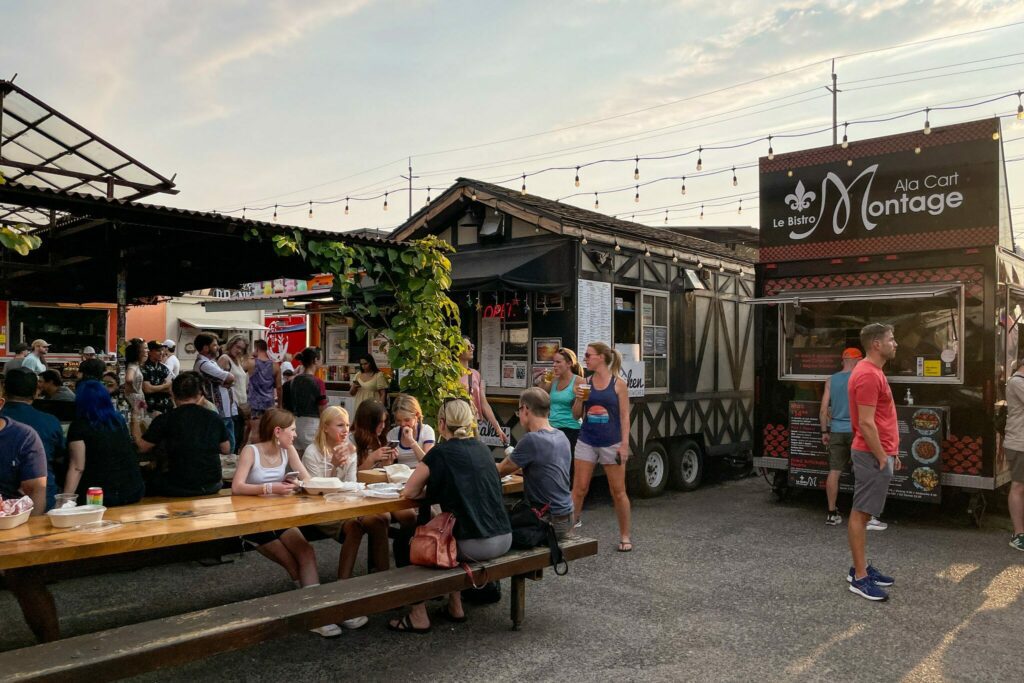
Listen, Portland’s food scene has become most famous for its food carts over the past decade or so, and eating at a food cart pod is absolutely something you should prioritize while you’re in town.
Portland is an excellent food city, and we say that as two people who eat gluten free by necessity (sometimes Alysha gets to cheat, but Matt has Celiac Disease and will get deathly ill with just a crumb of gluten).
Most of the time, our itineraries for visitors who come to hang out with us involve one or two more “touristy” things, and then as many different food stops as we can fit in between.
An important note here: many of the places mentioned in this guide are NOT necessarily gluten free.
Alysha (and friends) do a lot of, uh, “research” about the gluten-filled food offerings in Portland.
If you’re gluten free, like Matt, then you should head over to our guide to the best gluten free eats in Portland for our take on the gluten free scene (which is EXCELLENT).
Food carts are, without a doubt, one of the unique aspects of Portland’s underrated (though quickly moving into “rated” territory) food scene.
In fact, food carts are one of Matt’s favorite soap boxes to get up on.
Here’s the short version of why food carts are an important aspect of a city’s food ecosystem.
In other major cities on the west coast (yes, we’re including Portland in that group), it is so incredibly expensive to start a food business thanks to astronomical rents, intense competition, and continually rising food costs.
Combine that with the fact that margins in restaurants are notoriously thin, and you’ve got yourself a recipe for very little culinary innovation.
The only way to try something new in those cities as a brick and mortar is, essentially, to already be famous and use that fame to bring in investment in the seven figures for a big buildout.
Food carts offer a way to lower the barrier to entry for opening a food business. Which means a whole lot more trying new stuff!
Then, when a concept is proven, it can move on to bigger and better things. Usually, it’s a pipeline that starts with food trucks, turns into pop ups, and ends with opening a brick and mortar.
There are many, many restaurants in Portland that started as a food cart. In fact, one of our favorite restaurants – Rangoon Bistro – has made that exact journey, and they have now opened a SECOND brick and mortar location.
The tl;dr is that Portland has done a great job cultivating the food cart culture, should continue to do so, and more cities should probably consider doing the same, because it leads to a more interesting, diverse food scene.
Anyway, stepping off the soap box, let’s talk about our favorite food cart pods – usually a collection of food carts with an onsite bar – around the city.
Prost! (location): This pod is near the first place we lived in Portland, though we had been here many times before actually moving here because we LOVE DesiPDX. Particularly their cardamom chai chicken. There’s also Matt’s BBQ, which is a famous spot for Texas BBQ that consistently sells out by early afternoon.
Hawthorne Asylum (location): The biggest pod on this list, this place is right in the heart of the Central Eastside and has a huge seating area. For us, the star of the show here is the excellent (gluten free) fried chicken at Your Side Chicks, which was started by a veteran chef who exited the grind of working in restaurant kitchens in Vegas and wanted to do his own thing. And he does that thing extremely well! You also can’t go wrong with the dumplings from Pelmeni Pelmeni.
Hinterland (location): While there are only a few food carts here, the quality is high and this is the best bar setup of these three pods. The drinks are great, and the food cart pods include Matt’s BBQ Tacos, the taco-focused offshoot of Matt’s BBQ with the same smoked meats served up on homemade tortillas.
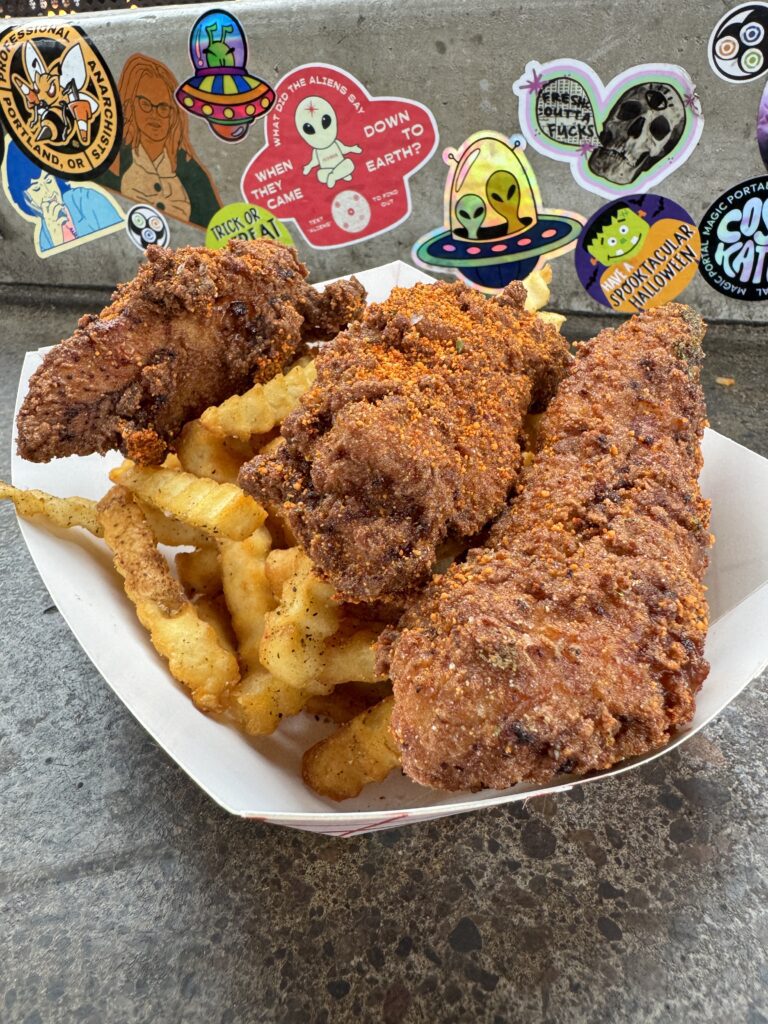
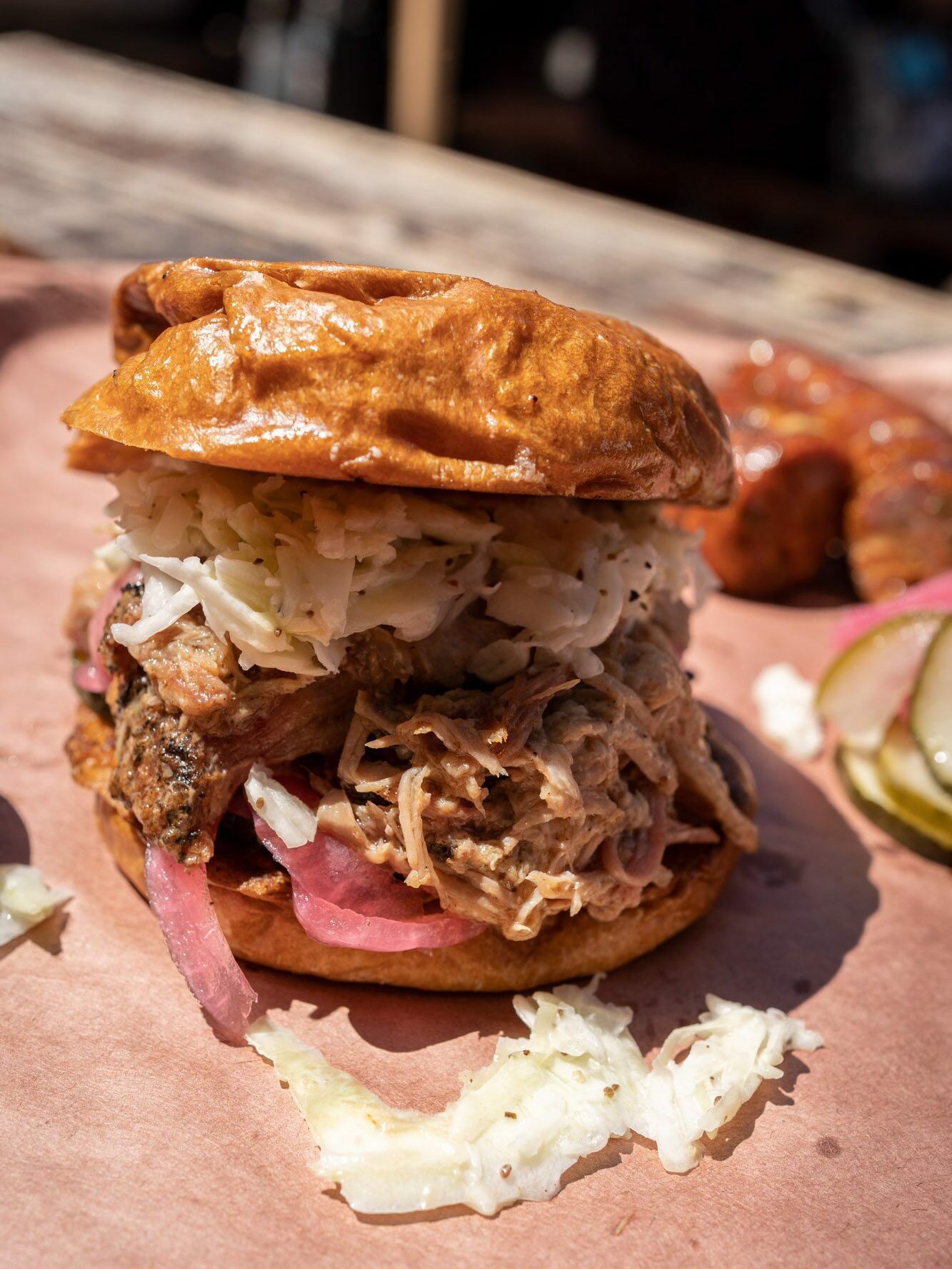
There are, obviously, numerous other food carts around the city, some of which aren’t even a part of a pod (for example, we love Honey Butter Country Fare for their gluten free corn dogs with great vegan options in a dedicated vegan fryer).
Kim Jong Grilln is also worth a visit downtown at Cart Blocks, especially when they have their copycat Crunchwrap Supremes!
If you’re looking to experience Portland’s food carts with a local guide, this guided tour will take you to a couple of pods in the Central Eastside (including one that we mentioned above) for a sampling of different food carts.
See the Rest of Portland’s Parks!
Portland is a city full of excellent green spaces, and there are plenty of other parks to check out in addition to the one we’ve already mentioned above (Washington Park).
We’re going to give you three parks that are relatively accessible to downtown and offer something cool and unique (though there are probably 20 parks that could be on this list).
Mount Tabor
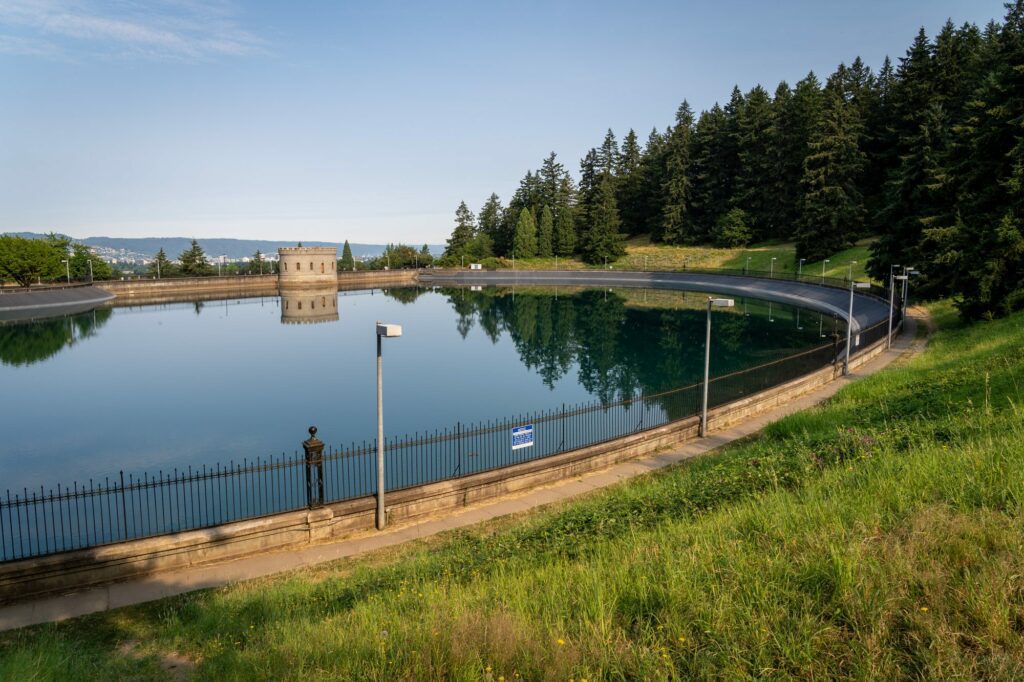
Mount Tabor is the closest park to us, and is the one we find ourselves visiting most often these days.
There’s a nice, relatively easy loop hike that takes you up past reservoir #5 (the view from the top of the stairs is great) and around the perimeter of the park on a nice, forested trail.
For one Saturday during the summer, the park turns into a Soapbox Derby course, where creative Portlanders (we’re constantly impressed with the ingenuity and creativity that exists in this city) build their own, uh, vehicles (?) and set off on the winding path from the top of the hill to the bottom.
It’s a fun day out that epitomizes Portland’s spirit and is worth catching if you’re in town.
Peninsula Park
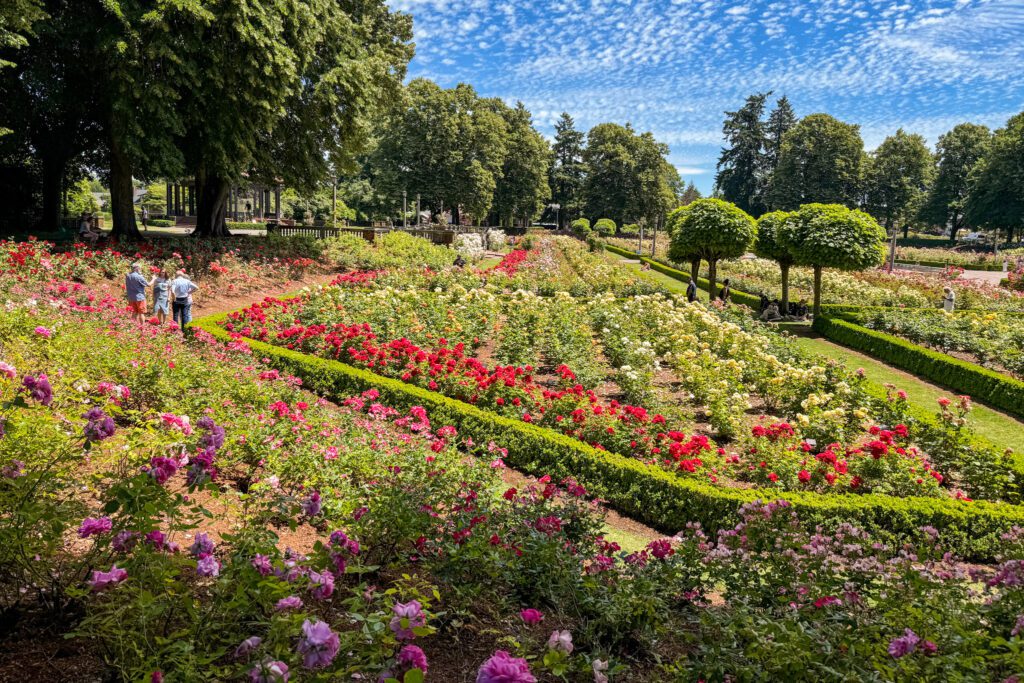
Peninsula Park is the OG rose garden! Far less popular with visitors, this is a gem in Northeast Portland that we used to walk up to when we lived nearby.
It’s equally stunning as the International Rose Test Garden, with far fewer visitors (though it does get busy on summer weekends with locals out and about picnicking and frolicking in the open fields at the back of the park.
The Crystal Springs Rhododendron Garden
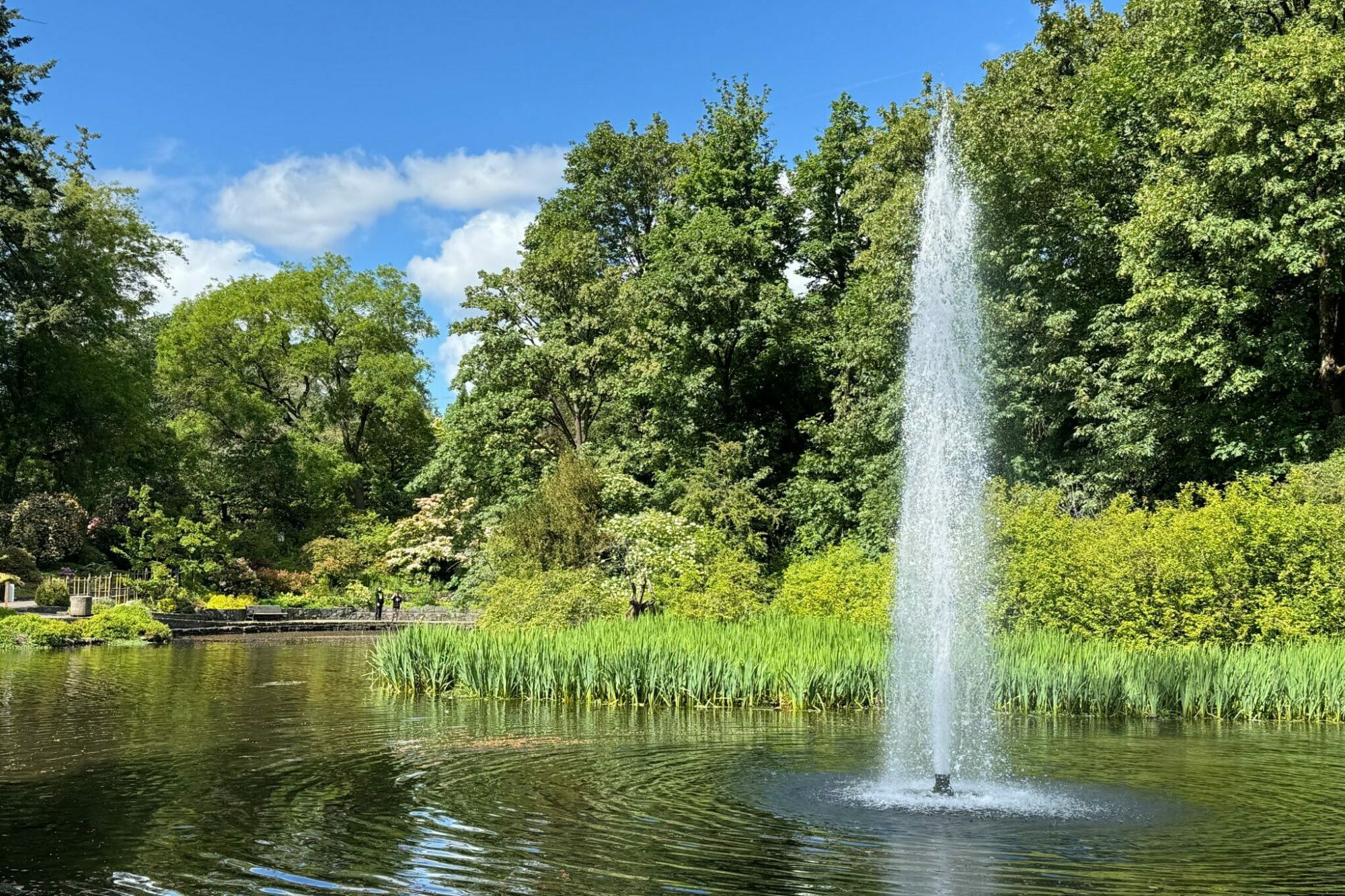
A less-visited but equally lovely plant-related activity is tucked away in southeast Portland in the middle of a golf course.
There, across the street from Reed College, you’ll find Crystal Springs Rhododendron Garden.
It’s not a particularly big space, but there’s a nice little trail that takes about 30 minutes to see the entire garden.
There are a bunch of rhododendrons, some water features, and plenty of ducks bobbing for food in said water features.
We also saw a muskrat, which we mistook for a beaver until realizing it was really just an oversized rat that happens to swim. Still, I had never seen one of those before, so that was fun!
It’s much, much less popular with tourists – partially because it’s a little out of the way of the normal tourist route – but we think it was well worth the price of admission and we bring lots of visitors here.
Take an Introductory Walking Tour
My favorite thing to do on my first day in a new city is a walking tour with a local guide. I view this as building a strong foundation for the rest of the trip because they give you three important things.
First, you get a crash course in history and culture, which is a valuable baseline that will make the rest of your trip more enjoyable.
Second, you get to spend a few hours with a local who will give you all sorts of tips about what to eat, drink (and see), and specifically where to find the best version of said things.
Last, but not least you’ll discover places that you definitely would never have found on your own.
We always do a walking tour on our first day in a city, and we recently realized that we have never actually done a walking tour in Portland.
So I, Matt, set out to change that, and headed downtown on a sunny summer morning to do a walking tour with a local tour company.
This is the walking tour I chose based on my research, and it’s a two hour (ish) stroll around the downtown core that will give you a solid understanding of Portland as a city, its layout, and its architecture.
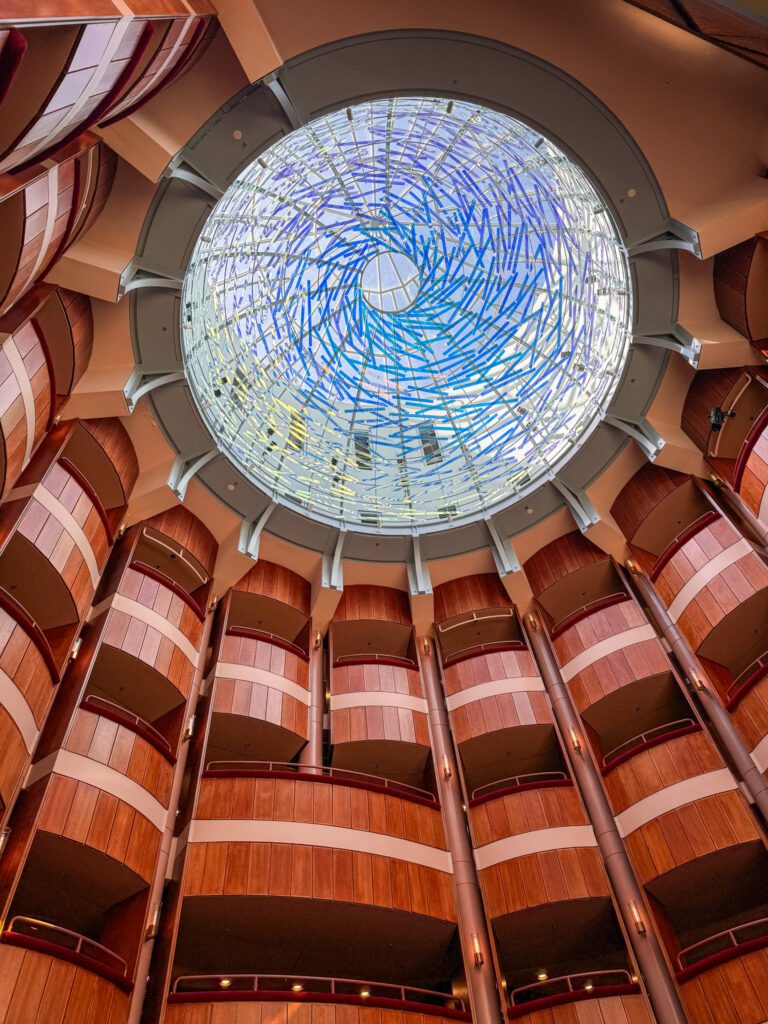
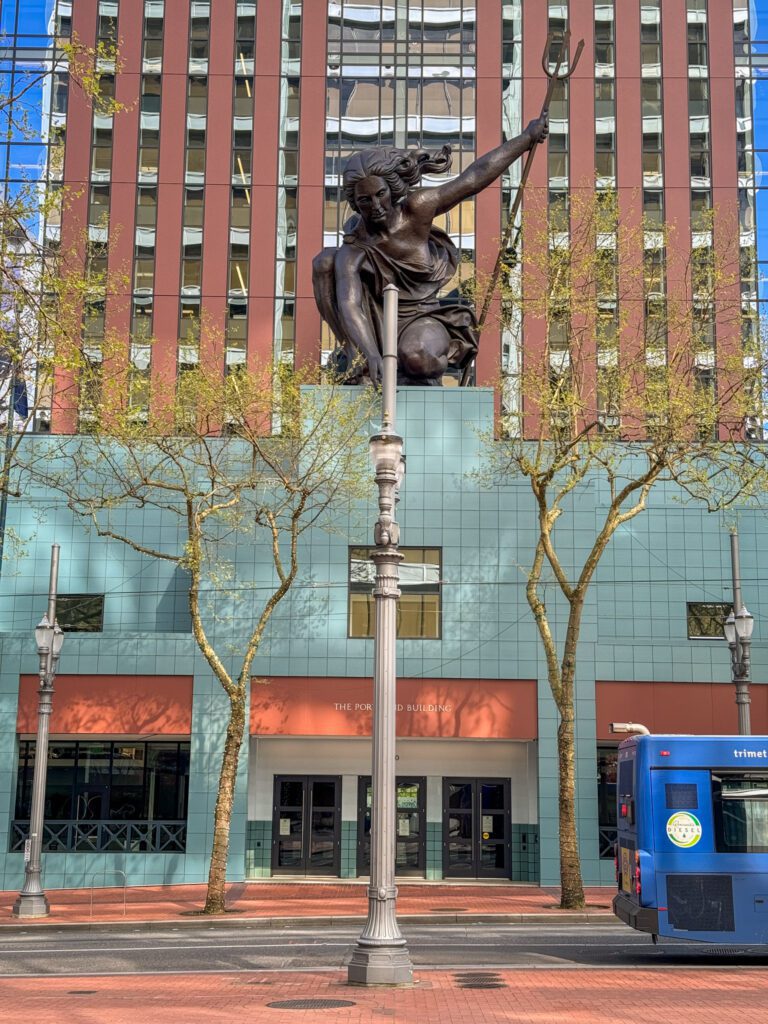
The guide will take you to a few cool spots that I, a Portland resident, had never actually visited, and you’ll get some context and history before diving deeper over the course of the rest of your trip.
Crucially, the guide will give you access to local knowledge about what to do, see, eat, and drink while you’re in town, and will happily answer any questions you might have.
Learn About Oregon History at the Oregon Historical Society
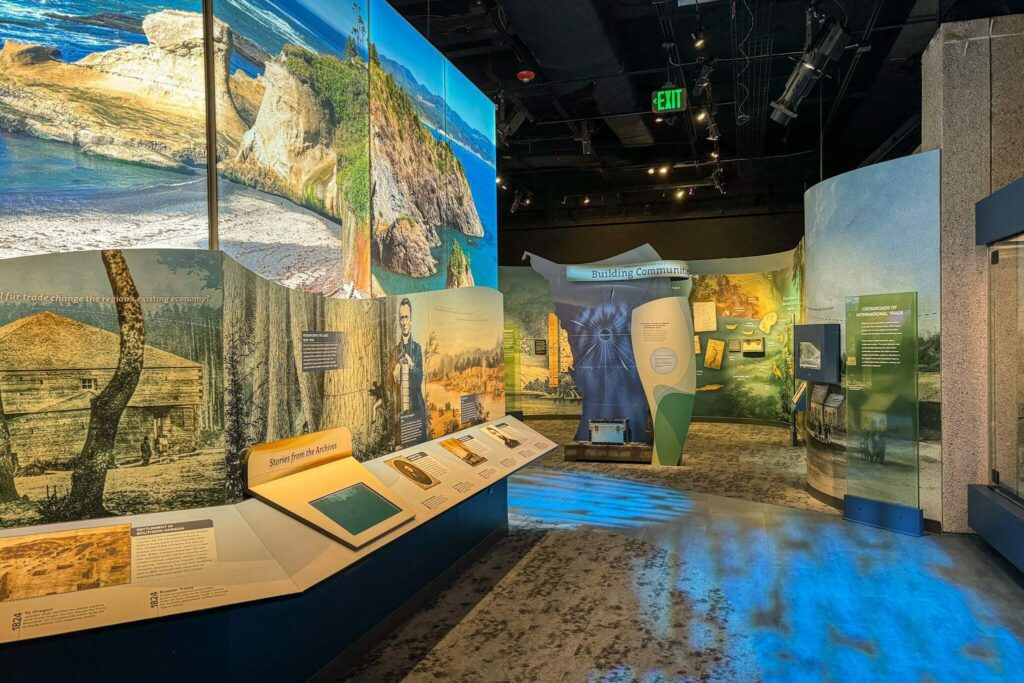
Whenever we travel, we generally try to make one of our first stops the history museum in a given destination so that we have a little bit of historical and cultural context that we can use as a foundation for the rest of our trip.
And yet, somehow, we had not made it to the Oregon Historical Society after 10 visits to Portland and almost two years of living here.
The Oregon Historical Society is on the South Park Blocks, across from the Portland Art Museum, and it’s FREE for Multnomah County residents ($10 for nonresident adults, $5 for kids).
Well, on a drizzly Wednesday morning, we finally made it! It happened to be the 165th anniversary of Oregon’s statehood, and we were one of a few people wandering the halls.
The thing we like about the museum is that it’s very focused, and unlike other museums around the world, it’s completely reasonable to expect to spend about an hour here and walk away with a baseline understanding of how Oregon’s history has shaped the city of Portland and the state as a whole today.
The highlight, by far, is the permanent exhibit on the top floor that gives an in-depth historical recollection of Oregon’s complex and fascinating history.
It starts with a short video explaining what you’re about to dive into, and then it winds its way through the history of Oregon, starting millions of years ago with how geological forces shaped the state, moving through the Oregon Trail and John Jacob Astor’s failed fur trading company, and ending with present-day.
There are two things about this museum that I really, really loved.
First, they do not shy away from the more problematic aspects of Oregon’s history.
For example, the fact that Oregon explicitly excluded Black people at its founding and well into its official statehood, and the fact that Oregon (and the federal government) stole most of the land from the indigenous people who had called it home for thousands of years.
One of the most interesting ideas (to us, anyway) that the exhibit presented is the concept that ideas about land ownership was at the root of much of the conflict between settlers and tribes.
Settlers (and America as a country) viewed land as something to own, which is not at all how the various tribes viewed their homeland.
Going into the exhibit, I knew that Oregon had some issues around race that help explain why it’s far less diverse than, say, Seattle or San Francisco, even today, but I don’t think I understood the depth of it.
Which brings me to the second thing I appreciated; they brought the receipts.
One that stood out to me was the contemporaneous recording (by recording, I mean a written recording) of Joe Palmer, one of the early people in charge of “Indian Affairs,” basically saying during treaty negotiations that there is nothing stopping America from coming back in 20 years and taking the land they were negotiating over (turns out, that’s exactly what happened AND Palmer was fired for being too generous to the tribes during negotiations).
Other “receipts” included a copy of the original Exclusion Act in 1844 that barred free Black men and women from coming to Oregon, a copy of a map from the Home Owners Loan Corporation showing the redlining that happened in Northeast Portland, and plenty of other examples.
As you can imagine, the first half of this exhibit is more than slightly depressing.
But then you get into the 20th Century, when Oregon became one of the most progressive states in the country, particularly around environmental protections.
We had the first minimum wage law, the first gas tax, and the first law requiring timber companies to replant after they cut down trees for lumber.
It’s a hard thing to wrap your head around, and I’m looking forward to learning more about how that shift happened.
At the end of the day, we’ve been to a bunch of similar museums around the world, and many of them handwave away the more controversial pieces of history (for example, a museum in New Zealand that never once mentioned how exactly the British settlers happened to get all of the land from the indigenous Māori people), and the Oregon Historical Society presents it in an objective, fair way.
Between the information and the way it’s presented, it’s a very rich and interesting history that is worth an hour or so of your time before you move on to enjoying modern-day Portland.
Explore Portland’s Coolest Neighborhoods on the Eastside
Here’s an extremely lukewarm Portland take: the best part of Portland is found on the east side of the Willamette River, which bisects the city and separates the more urban west side (which is where you’ll find downtown) from the more residential eastside.
When we talk to people about Portland and find out that they visited, but never made it east of the river, we laugh because it turns out they missed out on the best part!
When people come to visit us here, we almost always spend the majority of our time east of the river (with some forays west for things like the Rose Garden and the downtown Powell’s).
It’s sort of similar to Seattle in that way, I guess.
In Seattle, we always recommend adding neighborhoods like Capitol Hill, Ballard, or Fremont to your Seattle itinerary, regardless of how much time you have, because it offers a different perspective on the city that you won’t get if you just stay downtown.
Maybe it’s because all of the places to stay are in a pretty tight cluster downtown? We’re not sure why some people never leave that area, but the point here is that you definitely should.
Here are three neighborhoods that we think are worth adding to your itinerary, and some of our favorite places to eat, drink, and shop.
Mississippi Avenue
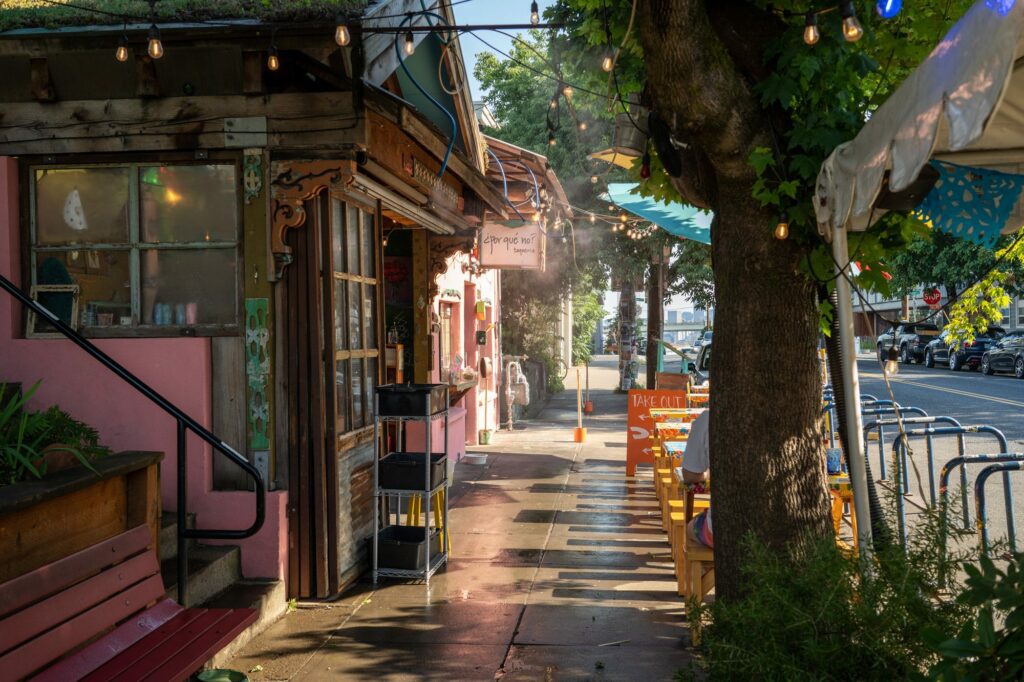
First of all, we love this area, and actually ended up a block off of Mississippi when we first moved to Portland.
It’s in Portland’s northeast quadrant, and is a hip area full of great places to eat, drink, and shop.
However, all of that relatively new development has come at a cost, and we think it’s worth taking a second to examine that cost before jumping into what to do, see, and eat on Mississippi Avenue.
We’re still learning about our new home, and after reading about the background of this area, this is our best oversimplified summation of decades and decades of history that have taken place in the Boise neighborhood.
If you’re interested in learning more about the context behind the development of the Mississippi corridor and Boise neighborhood, I learned a lot from this paper, and this article about the school in the neighborhood thinking about the causes and impacts of gentrification on them and their families.
Now let’s talk about Mississippi Avenue, and some of the places to eat, drink, and shop that we enjoy.
For food, our number one spot is the food cart pod at Prost! at the intersection of Skidmore and Mississippi (here on Google Maps).
There are a few food carts here that are among the best in Portland, a city of amazing food carts.
We love DesiPDX for Indian-meets-Pacific-Northwest food (their cardamom chai chicken is out of this world good).
Fried Egg I’m in Love and their popular breakfast sandwiches also have an outpost here. Whoever does their sandwich naming should get a raise – go with the signature Yolko Ono with toasted sourdough, pesto, an over-medium egg, and a housemade sausage patty.
Last, but certainly not least, is Matt’s BBQ, who routinely sells out of their Texas barbecue on a regular basis. Get a taster platter to try all of the various meats they smoke in-house.
Other good food spots on the street are Lovely’s Fifty Fifty for pizza, Gravy for brunch, and Blue Star for donuts. Oh, and how could we forget Kate’s Ice Cream for plant-based, gluten free ice cream! There are so many!
In terms of drinks, go to Stormbreaker for a great local brewery. We also like Interurban and their outdoor patio. And happy hour margaritas at ¿Por Qué No?
If you live in Portland (or got lucky with the dates you’re visiting) don’t miss the Mississippi Street Fair, which happens in early July and sees tens of thousands of people descend onto the street – which is closed to vehicle traffic – with all sorts of fun vendors.
The Central Eastside
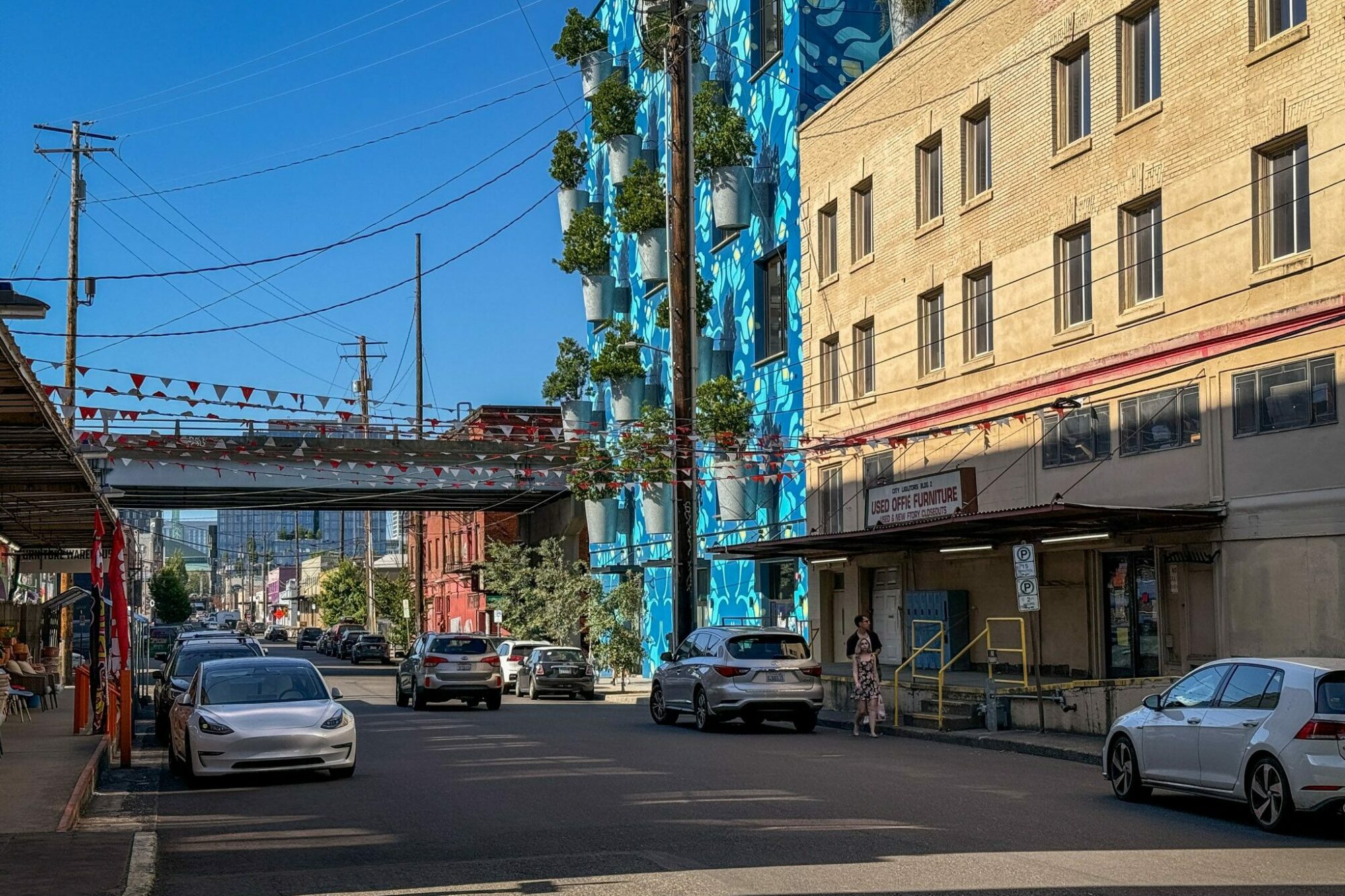
The Central Eastside is the area directly across the Willamette River from downtown, and its roots are very industrial, with big warehouses along the railroad tracks.
However, in recent years, there has been a noticeable effort to reinvigorate the Central Eastside with cultural events like the Portland Night Market and remodeled warehouses being used for office and commercial space.
The Central Eastside is probably the single neighborhood where we find ourselves most often in Portland. Which probably has something to do with the fact that we live nearby, but still. There’s a lot going on!
The point is that there is a good mix of places to eat in the Central Eastside. Here are a few that we like.
Hawthorne Asylum: As we mentioned above in the food cart section, this is one of our favorite – and the most developed – food cart pods in Portland. There are 15-20 carts here, and a big seating area to enjoy their food (with fire pits in the cooler months!). We come here for Your Side Chicks, a cart making excellent gluten free fried chicken (his whole thing is that the chicken is fresh, not frozen, which means it’s much juicier), but you also can’t go wrong with the dumplings from Pelmeni Pelmeni.
Grassa: They serve a range of pasta dishes like carbonara and squid ink linguine, along with sides and drinks all made with fresh handmade pasta.
Lardo: One of the most famous sandwiches in Portland! This is the place to go for a sandwich and a beer post-hike.
Dos Hermanos Bakery: One of the best bakeries in Portland, you see Dos Hermanos a lot at other coffee shops and cafes around Portland since they have a robust wholesale business. They also have a cafe in the Central Eastside where you can get sandwiches made on their baguettes, along with all of their pastries and baked goods.
Afuri: A ramen spot hailing from Japan (fun fact: Portland is their only location outside of Japan!) specializing in crafting dishes with local, seasonal ingredients.
Obon Shokudo: Plant-based Japanese comfort food. Think onigiri, udon, and curries. A fan favorite among our vegan friends, but Aysha also loves it.
Shalom Y’all: Some of the best Mediterranean food in Portland. Don’t miss the Halloumi, pita delivered straight to your table from the wood fired oven, and fun cocktails (the Turkish Delight Slushy is perfection on a warm summer day).
Here are some other spots in the Central Eastside that we think are well worth a stop.
Revolution Hall: If you’re looking for a great rooftop patio where you can grab a drink with a view, this is our favorite spot in Portland. It’s an old school that has been turned into a concert venue on the ground floor with a rooftop patio. It’s very vibey, but there’s something special about sitting up there with a view of both downtown and Mount Hood on a warm sunny day.
Smith Teamaker: Perhaps Alysha’s single favorite place in all of Portland? If you’re a tea lover, this is basically a must-stop. Their flagship here in the Central Eastside is where they pack all of the tea, and as soon as you’re within half a block you get wafting smells of whatever tea they happen to be packing that day. They have a vast menu of teas, including tea lattes and tea flights. We like the nitro chai, which is very unique (there’s no dairy, but the nitro gives it that creamy mouthfeel). It’s also a good place to grab edible souvenirs (read: tea) to take home.
Sunflower Sake: Another of our very favorite spots in Portland, Sunflower Sake is everything we love about Portland’s food and drink scene packed into one cozy high-ceilinged, industrial-chic space. Nina, the proprietor here, is passionate about many things, and they all come together in this space dedicated primarily to the world of sake. Which we knew next to nothing about before making semi-regular visits to Sunflower to introduce visiting friends and family to sake. It’s a one-person show, and Nina’s passion shines through every time I talk to her (I just like listening to passionate people talk about whatever thing they’re passionate about).
Cowbell Cheese: Another gem in the Central Eastside! Cowbell is a lovely little cheese shop tucked into what must have been a garage at one point. They have a rotating selection of cheeses from small producers all over the world, and the staff are super knowledgeable and able to help you find something you like. They also have some fun imported products for sale, and make a mean sandwich.
Portland Syrups: We really enjoy Portland Syrups, which are basically flavored syrups that you dilute with sparkling water and/or alcohol to create your own soda-ish concoctions (and avoid buying plastic bottles of soda or flavored sparkling water when paired with something like a Sodastream!). They’re born and bred – and still produce everything – in Portland. They have a brick and mortar location in Portland where you can buy a wide range of their flavors (and they’re generous with letting you try them here). Another good souvenir to bring home.
Cargo: This store is super fun! Situated in a classic Central Eastside warehouse space, it’s basically an upgraded version of World Market, with knick knacks, cards, clothing, textiles, and more from all over the world. It is huge and covers two floors, so plan to spend some time wandering.
Division Street
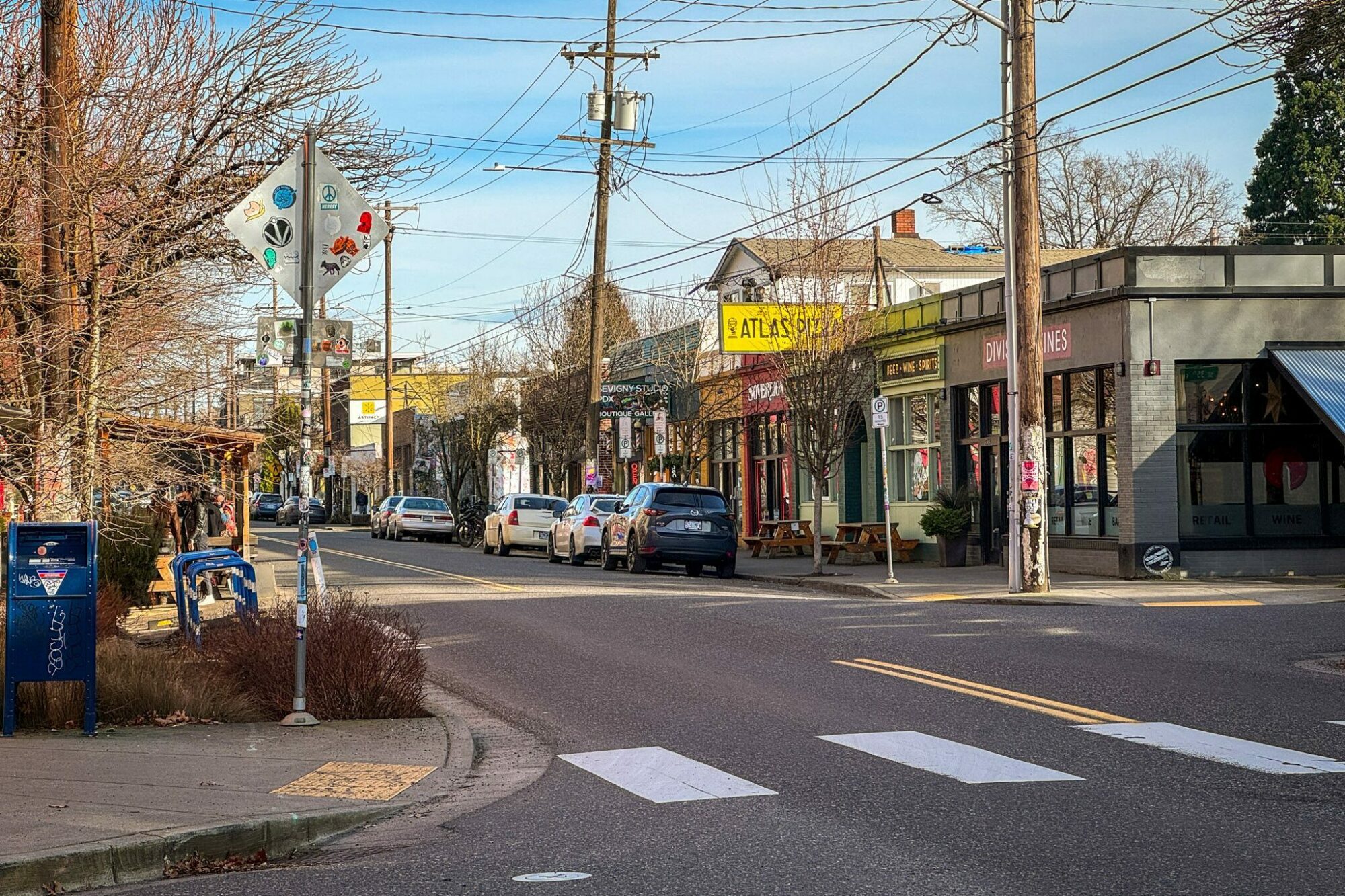
We saved the best for last here, and we’re more than a little biased because we live within walking distance of Division.
This is our single favorite stretch in the city – Division Street between SE 20th Ave and SE 50th Ave – and this stretch is a major part of why we moved here.
Here are some of our favorite spots to eat, drink, and be merry along Division.
Alysha also really loves Artifact, a consignment shop on Division that has an eclectic collection of recycled clothes, furniture, art, and more.
However, unlike other consignment stores where it’s a mix of more modern items and items from your grandma’s wardrobe, everything here is modern!
For Dinner
There are an endless number of great places to eat and drink along Division, so we’re having to do some picking and choosing here.
Rangoon Bistro: One of our favorite restaurants in Portland! They are a classic food cart to full restaurant (and now, two!) story, and it’s easy to see why. Their food is fantastic. Particularly the fried chicken and Laphet salad.
Magna Kusina: A block off of Division in the Clinton Triangle, this place started as a pop up and has quickly become one of the most popular places to eat in the neighborhood. It’s Filipino food, and it’s a mix of street food, small plates, noodle dishes, and bigger proteins. It’s a great introduction into Filipino food, if that’s something you’ve never tried before. They’ve begun expanding into different pop ups featuring their chef friends, which is fun. Make a reservation!
Kashiwagi: We walked by this tiny spot tucked into the back corner of a nondescript parking lot all the time before finally realizing that it was a very popular, very highly rated bento and sushi place. They have good lunch specials, and are very affordable.
The Turning Peel: Excellent sourdough Neapolitan pizza served in a classic Portland Craftsman style home with an even cuter patio. Do not miss the tiramisu when they have it!
Ava Gene’s: A little more upscale here, they serve Roman food made with fresh Pacific Northwest fruits, veggies, meats, and cheeses.
Oma’s Hideaway: While everyone still mourns the loss of Pok Pok, a Division Street institution that closed in 2020, Oma’s fills the void with incredible hawker food from Singapore and Malaysia. The roti, a handmade flaky Malaysian flatbread, served with parsnip & squash curry hits the spot every time. Plan to share so you can try a bunch of dishes, and be ready for spice.
For Sweets
For a post-dinner treat, there are two places along Division that really stand out from the crowd.
Lauretta Jean’s: When was the last time you had pie that wasn’t on a holiday? It doesn’t happen often for us, and walking into Lauretta Jean’s is heaven for pie lovers. They sell pies by the slice and full pies with a wide range of flavors, including rotating fruit and chocolate options. You really can’t go wrong, but salted honey and coconut cream are Alysha’s favorites.
Pinolo Gelato: Easily the best gelato in Portland, and perhaps the best gelato on the west coast (?). They source ingredients from Italy, and it shows (their pistachio gelato is a darker brown color, not a fluorescent green, which is a sign that it’s made with real pistachios without colorings). It was started by an Italian-American born in Pisa, and it’s legit really, really good.
For Drinks
Division Wine: Our favorite wine bar in the neighborhood, the selection is big and the prices are (relatively) small here. Plus, the staff are extremely helpful. The last time we were here, we had friends from California in tow who had a specific view of chardonnay that leaned into oak, which is not how it’s made in the Willamette Valley. We asked our server to help us find some Chardonnay that would change their minds, and he delivered! Get a flight, which features surprisingly hefty pours. They usually have several bottles open that aren’t on the menu, so ask your server for help!
Schilling Cider: If you didn’t already know, the Pacific Northwest is the center of the world’s apple production. Specifically, Washington State and the area around Wenatchee, but northern Oregon produces a fair amount of apples too. Schilling – which Matt knows from his days living in Seattle, where they started – has a cider bar with 50+ different hard ciders on tap, and it’s a great place to either get acquainted with the world of cider, or for cider lovers to try some local options.
Imperial Bottle Shop & Taproom: A spot for beer lovers to try beer from multiple breweries around Oregon. They have an outdoor patio, too, and it’s a great place to spend a warm summer evening with friends. Lots of bottles and cans to choose from, too.
Little Beast Brewing: Portland’s craft beer scene is famously good, and Little Beast’s Beer Garden on Division is a good place to experience it. They have a nice (covered and heated in the winter and spring) outdoor patio, a food truck and live music on weekends, and an eclectic range of beer (including too many different IPAs to count, several sours, and rotating seasonal beers).
Catch a Timbers (or Thorns) Game
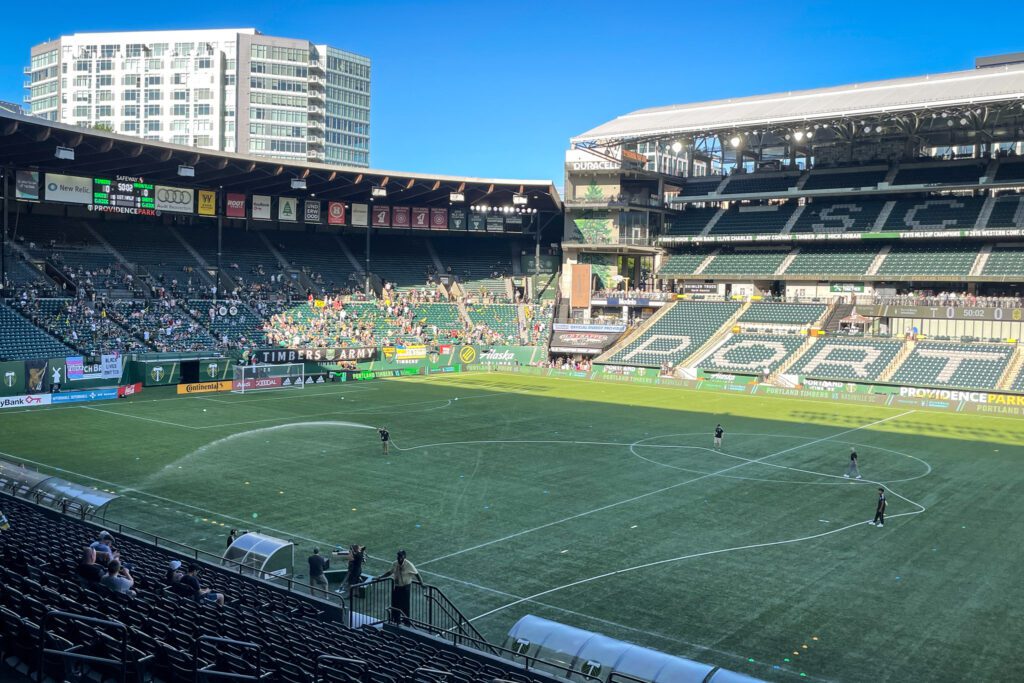
Matt is a gigantic soccer nerd (he used to coach club soccer in Seattle), and loves live soccer in just about any form.
The Portland Timbers play in Major League Soccer, the highest level of professional soccer in the US, and are known for having one of the best atmospheres in the country (okay, THE best) thanks in large part to the Timbers Army, a committed group of Timbers fans.
A lot of times, you’ll find that the stadiums for major sports teams around the world aren’t really in the center of the city, and it can take an hour or two to get there and back. Which, given a short visit, isn’t entirely feasible.
However, Providence Park, which is where the Timbers play, is smack dab in the heart of downtown Portland. Many locals even ride their bikes to the games!
The Portland Timbers are one of the most successful franchises in MLS, Major League Soccer (the top soccer division in the US), and while they’ve been a little down on their luck over the past few years thanks to an aging roster, it’s still worth catching a game at Providence Park if you have never been.
There are two reasons why you should add a Timbers game to your Portland bucket list (or itinerary).
First, it’s widely regarded as one of the best atmospheres in the league. Especially when our rivals, the Seattle Sounders, are in town.
The way the stadium is structured has the Timbers Army – the supporters section – directly across the field from a concrete wall, which the sound rebounds off of.
Second, it’s one of the few stadiums in MLS that is both soccer-specific (many MLS teams play in a football stadium, which creates a very different vibe) and right in the middle of the city (it’s a 5-10 minute walk from Powell’s City of Books).
Check the schedule here – the season runs through the summer and fall, with most games falling on weekend afternoons and evenings.
We’ve also been enjoying the Portland Thorns, the NWSL (the women’s soccer league in the US), who also play at Providence Park. It’s a different crowd – less intense, more kids – and tickets are generally cheaper than the Timbers games.
Hike to Pittock Mansion
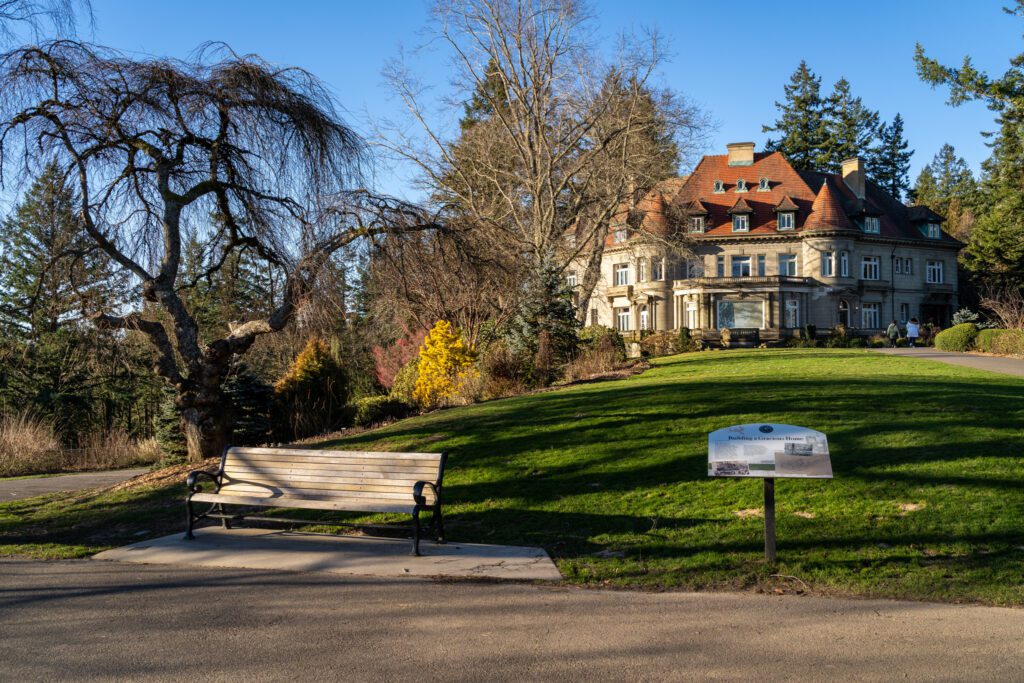
The hike to Pittock Mansion is our favorite hike in Portland (within city limits) mostly because it leads to our favorite view in the city from the grounds of the mansion, which looks east out over Downtown Portland with Mount Hood’s snowy peak looming in the distance.
The mansion itself was built by Henry Pittock, a paper and newspaper mogul, in the early 1900’s who controlled an early iteration of The Oregonian, which still exists in some form today (barely).
Can we tell you a secret? We’ve never actually been inside Pittock Mansion, mostly because seeing an old rich guy’s stuff isn’t particularly appealing to us.
However, the hike up to the grounds is absolutely worth it for that beautiful view.
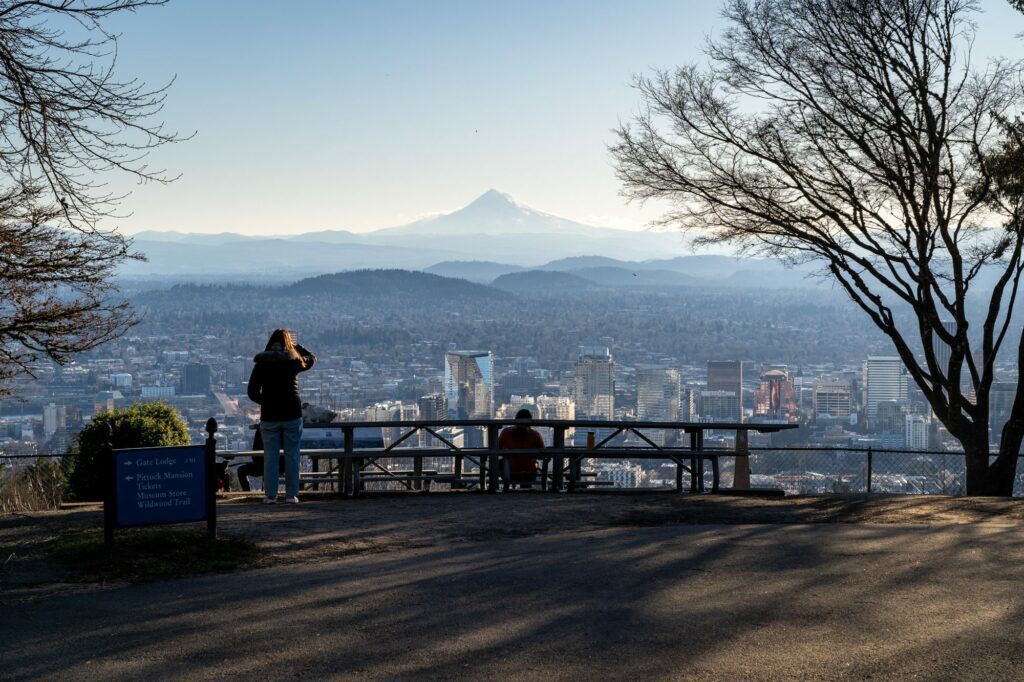
The best way to do it is to park at Lower Macleay Park (here on Google Maps) and hike along the creek, past the Witch’s Castle and up through the forest to Pittock Mansion.
You can shorten the hike a little bit by parking here, but you’ll miss the Witch’s Castle.
Catch a Show
We’ve been very blessed to live in cities with vibrant cultural calendars, namely San Francisco (and to a lesser extent, Seattle) where nearly every tour and act made a stop on their journeys around the US.
It’s certainly true that Portland is often left off of those calendars.
For example, during Taylor Swift’s Eras Tour, there was no date in Portland, so all of the Swifties we know ventured off to Seattle or California to see Taylor in action.
One of the issues for those bigger acts – the Taylors and Beyonces of the world – is that Portland doesn’t really have a venue big enough for them (there’s no NFL Stadium here, and Providence Park and Moda Center aren’t terribly massive).
However, Portland does have a thriving art and culture scene of its own. And it’s arguably just as interesting as those other cities.
We’ve seen multiple shows, from Les Miserables, Wicked, and John Oliver, to smaller musical acts at Mississippi Studios and the Aladdin Theater, and there is nearly always something to see in Portland.
We think that the best place to find out about what shows are happening around town (and when things are going on sale) is Everout – subscribe to their email list to get events emailed to you, including on-sale dates for most of the popular shows that come to Portland.
Experience OMSI (The Oregon Museum of Science and Industry)
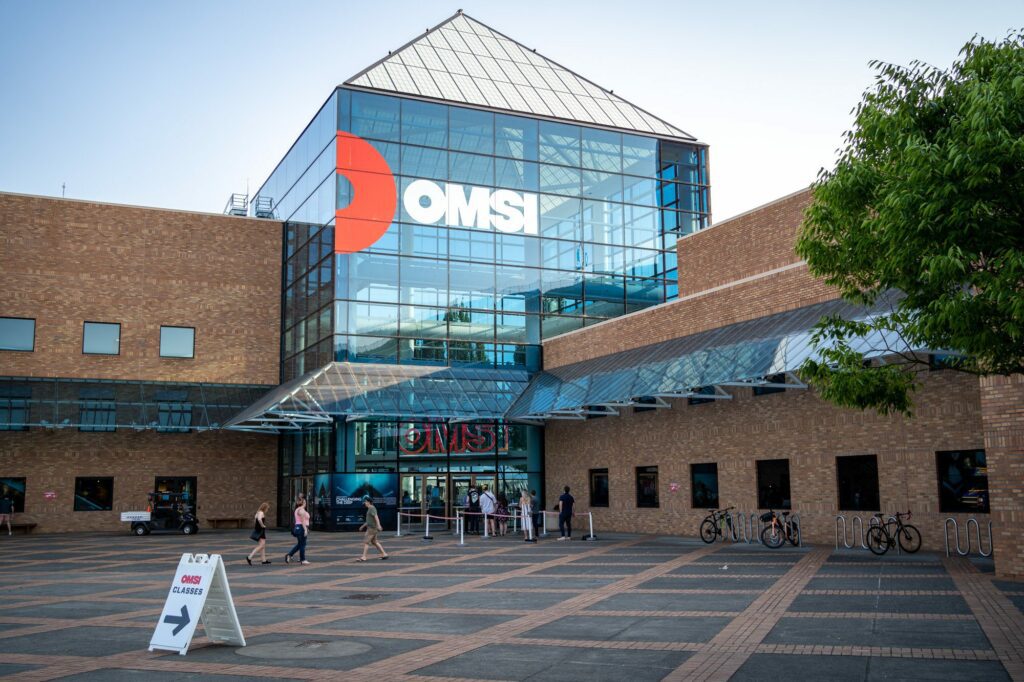
If you have kids, OMSI (the Oregon Museum of Science and Industry) is a fun way to spend a few hours.
It’s a cool museum with lots of interactive exhibits, mostly focusing on Oregon’s ecosystems and some rotating exhibits.
They also have a cool “after dark” series that sees the museum turn 21+ and serve drinks, featuring different themes and talks and exhibits related to those themes.
For example, we went to one focused on the ocean, and there were guest speakers about how re-introducing sea otters on the Oregon Coast are key to saving the world (from the excellent Elakha Alliance, and I’m only slightly exaggerating), a cool film about Great White Sharks in the huge theater, and various other features.
Escape the City to Sauvie Island
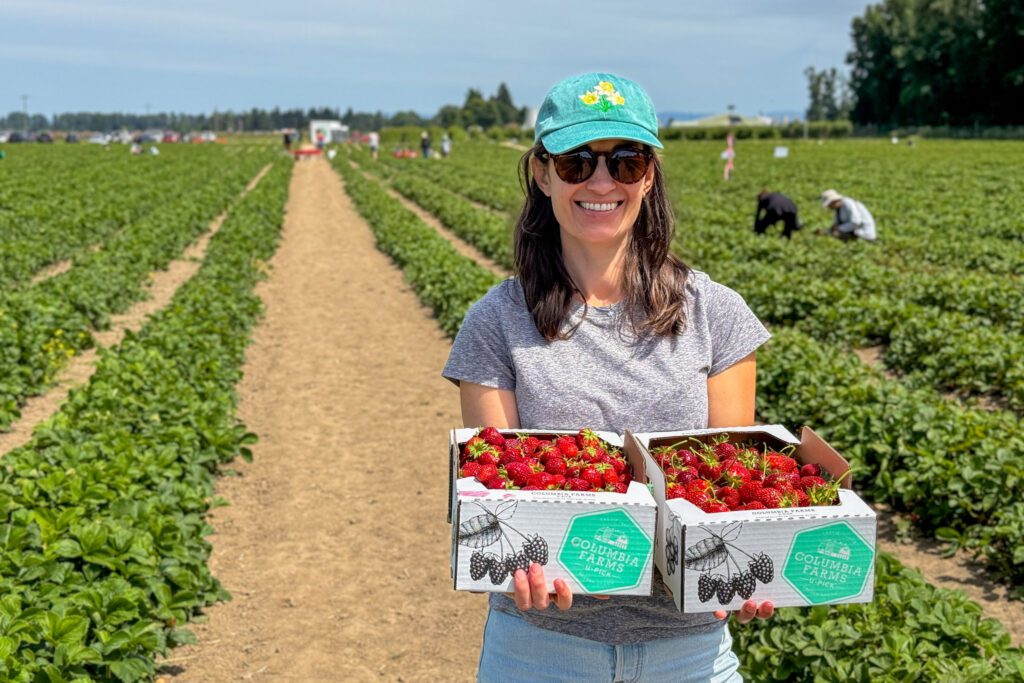
As we drove back from Sauvie Island on our latest jaunt, we were trying to figure out if there is a closer rural area to an urban center on the west coast.
Alysha grew up in a very rural area north of San Francisco, but it takes a solid hour to get from the city to the house she grew up in. In Seattle, where Matt grew up, it’ll take you 30-45 minutes or so.
Sauvie Island, which is home to all sorts of u-pick berry farms in the summer and pumpkin patches and corn mazes in the fall, is just 20 minutes away from downtown Portland.
Which makes it the closest rural area to a major city that we’ve ever experienced.
There are a couple of reasons to head to Sauvie Island, and the first is specific to the summer and fall. The farms!
There are all sorts of farms on Sauvie, and many of them open up for u-pick blueberries in the summer, and pumpkins in the fall.
It’s a fun half day excursion to take when you need a break from the hustle and bustle of the city (to the extent that hustle and bustle exists in Portland).
We love the Croft Farm, and have been out there to pick blueberries on a summer weekday morning when we were the only ones around.
We ended up with 10 pounds of blueberries, which we’re still working through as I’m writing this.
This past summer, we went out to Columbia Farms for u-pick strawberries, and ended up with double what we had planned.
Which led to a funny instance of Matt trying to finish them before they went bad, sitting on the couch with a huge bowl full of delicious strawberries on their last day.
In the fall, the Pumpkin Patch is the place to be for pumpkin picking and corn mazes!
One last plug for the summer farm-to-plate dinners under the oak tree at Topaz Farm! They have different themes each week, and it’s always served family-style (so you get to meet new people!) in a beautiful setting on their sustainable farm out on Sauvie.
The second reason to head out to Sauvie is, conveniently, best done in the winter and spring. The birds! Sauvie Island is paradise for migrating birds, which are much easier to spot when the greenery is sparse.
You could absolutely just drive around the island and look for birds (we’ve seen numerous bald eagles roaming around the island), but we love the easy hike out to the Warrior Point Lighthouse, which is almost completely flat.
If you want to do that hike, you need to pick up an island parking permit, which you can do at the Cracker Barrel just over the bridge (here on Google Maps).
Take a Day Trip
If you’ve read any of our guides, you’ll know that one of our favorite things about living in Portland is the fact that, within 90 minutes or so, we can be either on the Pacific Ocean, or in the mountains in the heart of the Cascade Range.
The concentration and diversity of natural beauty near Portland is astounding, and it means that there is a ton to explore within 1-2 hours of the city, which is the maximum distance for a day trip, we think.
So, while this isn’t technically IN Portland, it is absolutely worth considering as a “thing to do” while you’re here.
In this section, we’ll go through a couple of our favorites.
For more details, head over to our guide to the best day trips from Portland, where we go through each of these in more detail (and have plenty of other ideas, too!).
The Columbia River Gorge (for the Nature)
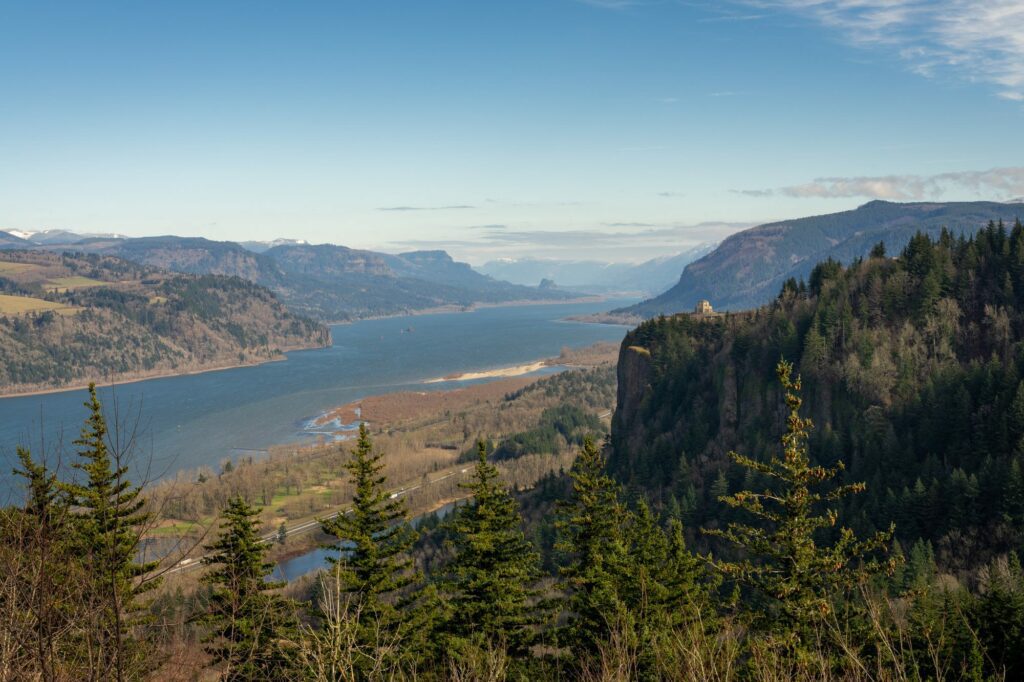
The Columbia River Gorge is roughly 45 minutes from our front door, and anytime we’re looking to escape the city for a morning immersed in nature, it’s usually our first stop.
We’re out there a lot, and we are endlessly fascinated by the interesting geography on display.
The biggest reasons to venture out to the Gorge are the hiking and the waterfalls.
Starting with waterfalls, towering Multnomah Falls is the one that draws the most visitors and while it’s impressive, it’s also swarming with visitors. We like Horsetail and Ponytail Falls, Latourell Falls, and Wahclella Falls too.
We have an entire guide dedicated to the waterfalls in the Columbia River Gorge, which is worth a read if you’re intrigued by waterfalls.
There are also some great non-waterfall hikes to do in the Gorge, and we particularly love Angel’s Rest and Coyote Wall.
We have an entire guide dedicated to the best hikes in the Columbia River Gorge, which covers all of our favorite hikes along both the Oregon and Washington side of the Gorge.
If you’ve never been to the Columbia River Gorge before, it’s our number one recommendation in terms of easy-to-access day trips from Portland.
For a perfect day out of the city, head out into the Gorge and stop at Multnomah Falls as early as possible (try to get there before 9am if you can).
Then head to the trailhead for your preferred hike for the day, and head to Hood River for lunch.
Explore the Hood River Valley, which is a fertile fruit basket with spectacular views of Mount Hood and Mount Adams, and then continue east deeper into the Gorge, where you’ll see the landscape get drier and drier.
End your eastward journey at Rowena Crest, a beautiful view of a picturesque bend in the road, and head back west. Stop at Loop de Loop Wines (our favorite) for a glass of wine with a view of Mount Hood before making the journey back to Portland.
Guess what? We also have an entire guide to planning a day in the Columbia River Gorge, with details around what exactly to do and see and how to organize your day.
If you don’t have a car, this is a good guided tour option that will get you out to the Gorge.
The Willamette Valley (for the Wine)
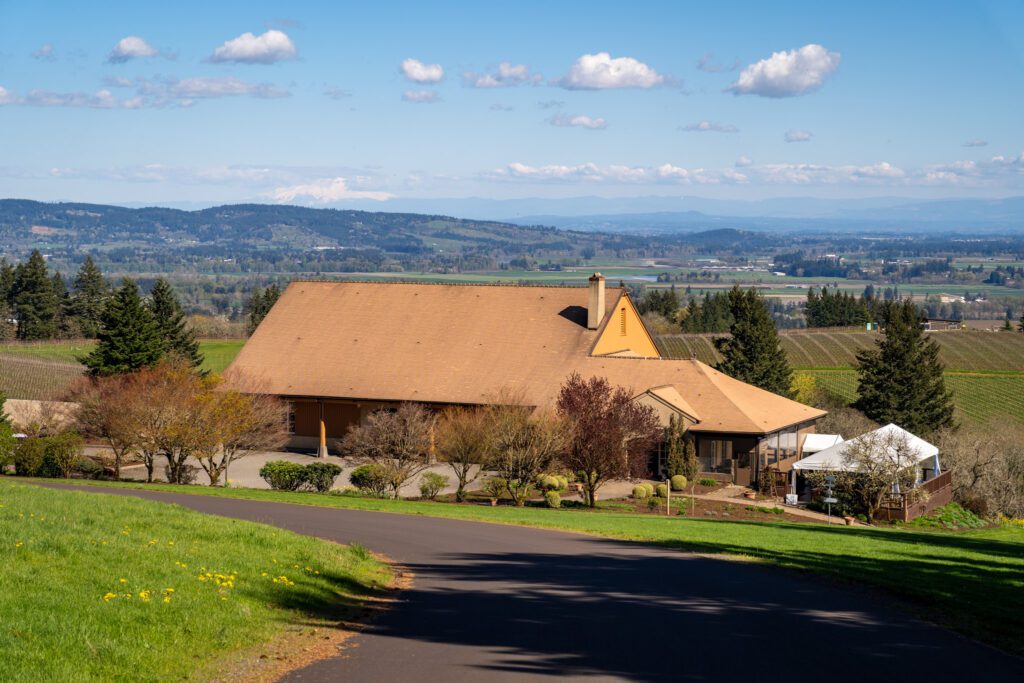
Before we get into exactly what to do and see in the WIllamette Valley, Oregon’s premier wine destination (and arguably the best wine region in the Pacific Northwest), a quick anecdote.
If you know me in real life or you’ve served me wine in Oregon over the past few years, you’ve probably heard this story already because it was a fundamental shift in the way I viewed Oregon wine.
Recently, a friend and I took a wine-focused trip to eastern France that brought us to Alsace and, more importantly for this anecdote, Burgundy.
Burgundy is one of the most prestigious wine regions in the world, and I was very surprised to meet multiple winemakers who perked up when I said I was from Portland, Oregon.
Normally, people aren’t quite sure where exactly Portland is, so we use the California border and Seattle as landmarks.
However, the people in the wine industry knew Portland because of the Willamette Valley, which has a similar latitude and climate to Burgundy and, as a result, focuses on similar varietals like pinot noir and chardonnay (though they’re presented very differently).
There is some very good wine coming out of the Willamette Valley, and it’s good enough that it’s on the map of some producers in one of the most prestigious wine regions in the world.
If you’re into wine, a trip out to the Willamette Valley is a must.
The best way to do it is by driving yourself (though there are guided tours if you don’t have a car or don’t want to drive so you can drink freely).
McMinnville is probably the best city to use as a home base for exploring the valley, and it has a cute downtown area with a walkable strip that is a good lunch stop.
Then venture out into the rolling hills of the upper Willamette Valley.
We really like Johan Vineyards and Day Wines, which offer a more modern take on wine with interesting fermentation techniques.
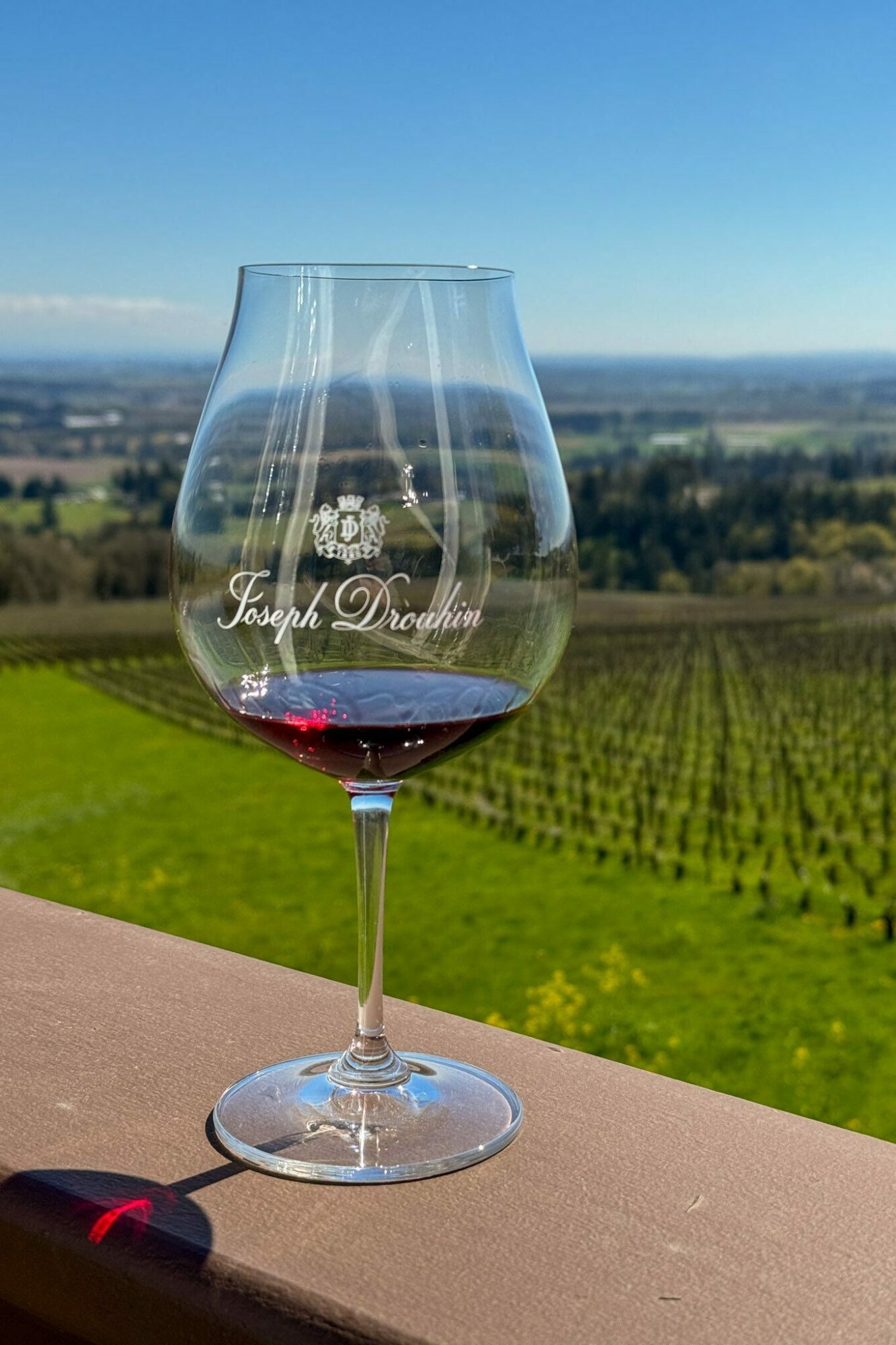
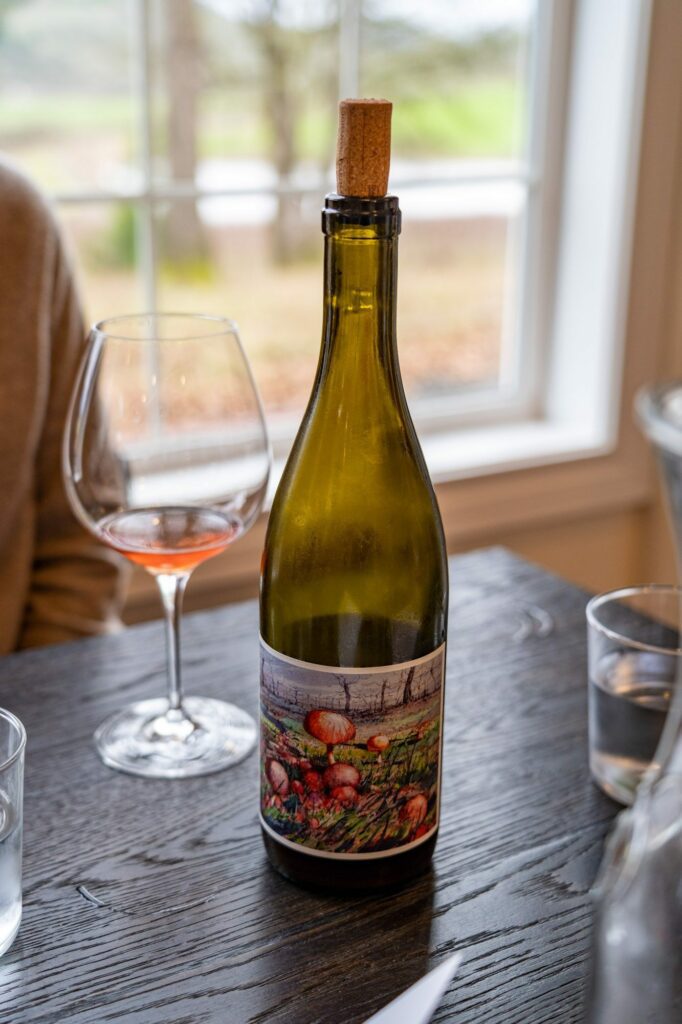
If you’re really wanting to dive into the Willamette Valley’s relationship with Burgundy, we’d head to Domaine Drouhin, which also has vineyards in Burgundy and has a tasting experience that has you trying wines from Oregon alongside their counterparts from Burgundy.
The Oregon Coast (for the Ocean)
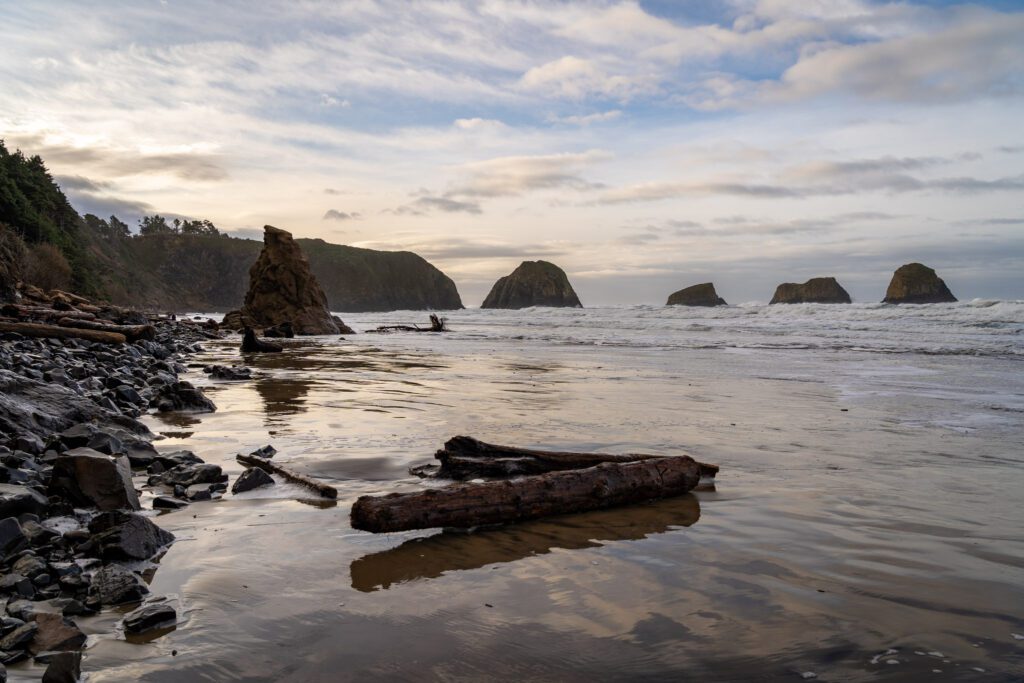
The Oregon Coast is gorgeous, and on any given weekend where the temperature in Portland hits 100, you’ll find a long line of Portland residents on Highway 26 heading west to embrace the cooler temperatures on the coast.
From Portland, you’re going to want to focus on the northern Oregon Coast, from Tillamook up to the northwest corner of Oregon in Astoria.
Each of those destinations is about an hour and a half from Portland, and if you’re up for a little extra driving, you can combine them into one big loop that sees a couple of them in one day (though we’d advise you to do Cannon Beach and one of the other two, which will make it much more achievable in a day).
Cannon Beach is great, and is the most popular destination on the coast. Haystack Rock, the giant sea stack on the beach, is among the most iconic natural landmarks in Oregon, and the two state parks that sandwich Cannon Beach – Ecola and Oswald West – have some great hikes within their borders.
Tillamook is almost directly west of Portland, and there are two main attractions in the area that make it worth a visit.
First, the Tillamook Creamery. If you are from the Pacific Northwest, you’ve absolutely heard of Tillamook.
Their cheese and, more importantly, ice cream, is synonymous with summers in Seattle, at least for me.
Their chocolate peanut butter ice cream is still the best single ice cream I think I’ve ever had (it’s the thick ribbons of peanut butter that do it for us, though it’s not gluten free so I can’t have it anymore).
They have a wide range of their dairy products – including some that you can only find at the factory itself (like cheese curds!) – along with an ice cream scoop shop with just about every flavor of their ice cream they make.
Second is the Three Capes Scenic Route, which takes you south out of Tillamook and down a particularly scenic stretch of road to three capes.
Those are Cape Meares (great lighthouse), Cape Lookout (great hike out to the point), and Cape Kiwanda (great sand dunes).
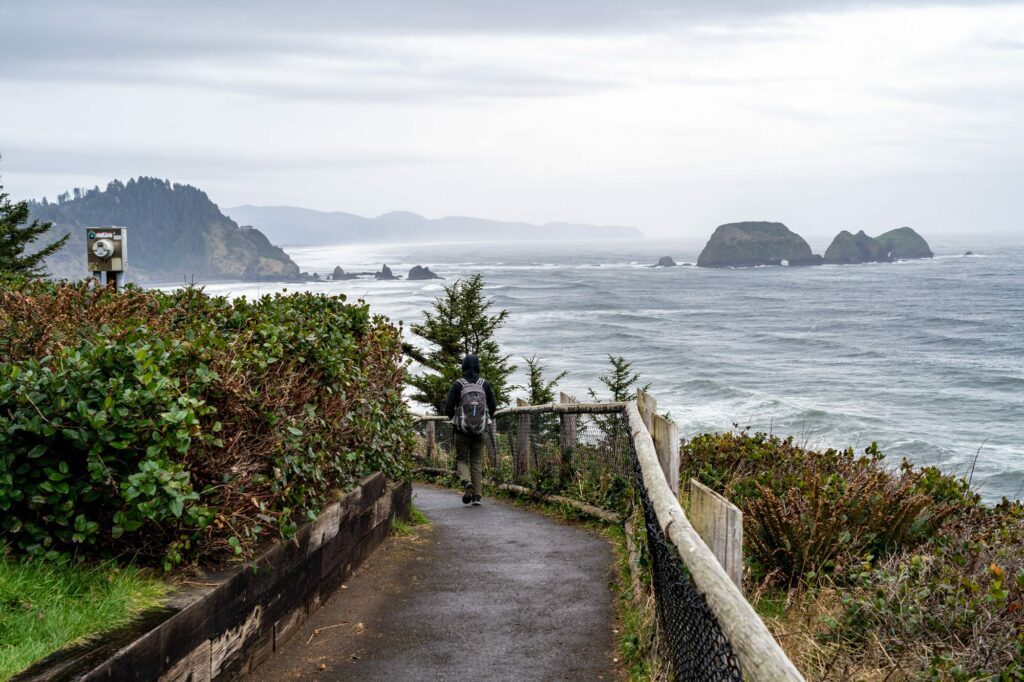
Last, but certainly not least, is Astoria. Astoria is the northwest corner of Oregon, where the mighty Columbia River meets the Pacific Ocean.
It’s where both Lewis and Clark ended their expedition, and where John Jacob Astor tried (and failed) to establish a worldwide fur trading empire and the “New York City of the west coast.”
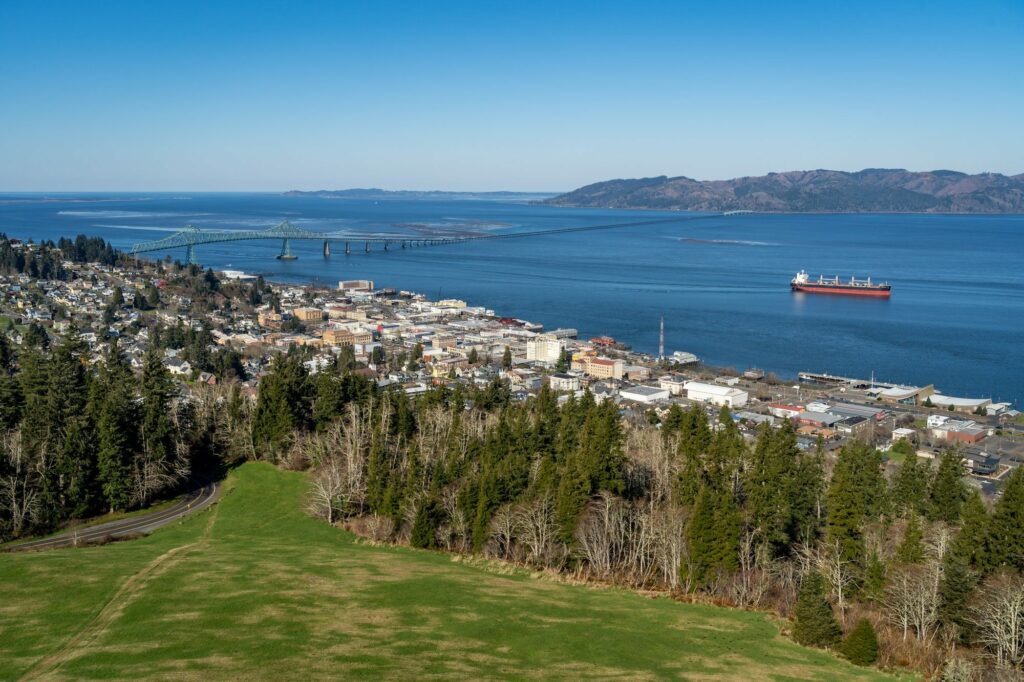
Though, he did get a city named after him, so there’s that.
We have an entire guide to the best things to do in Astoria, which you should read for far more information.
Drink Great Specialty Coffee (and Tea!)
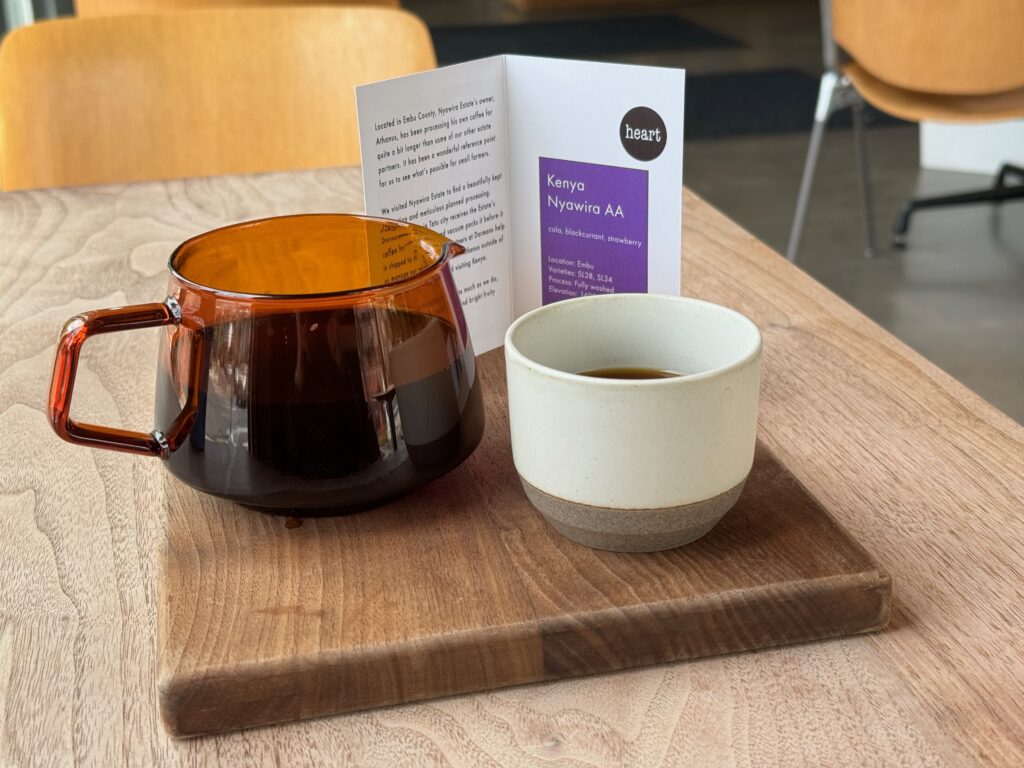
Recently, a fellow coffee lover texted me to ask what the best coffee city on the west coast is.
Having lived in Seattle, San Francisco, and now Portland (and immediately disregarding L.A. and San Diego based on my experiences there – it’s too sunny for people to need caffeine all the time!) I feel like I have a good handle on the options.
Portland is an amazing coffee city, and it’s a city where no matter where you are, there’s probably great coffee within a few blocks.
However, there are a few that stand out as a cut above the rest, and you can find them in my guide to the best coffee in Portland. Which one you should choose depends mostly on what you’re into.
If you want the best single origin filter coffees you can find in Portland, there are three places that you should add to your list.
The first is Proud Mary, who have an extensive menu of single origin coffees that rotate through and are available as either pour over or espresso (along with an equally extensive brunch menu).
The second is Electrica, which is run by Seiji and features an extensive coffee and tea menu, including pour over options that rotate every so often.
Last, but certainly not least, is Heart, which Matt fell out of love with on his journey exploring funkier coffees, and has recently re-fallen in love with as he returned to the world of fruit-forward washed coffees (which is Heart’s specialty).
If you want inventive signature lattes, head straight to Never Coffee in downtown Portland – I personally love the Midnight Oil, with star anise, fennel, and licorice – or to Less and More Coffee (also downtown).
If you want my favorite all around coffee spot in Portland, go to PDX Coffee Club, which focuses exclusively on roasters in Portland, and is run by Joe, the friendliest barista in town (and very much equally as nerdy about coffee as Matt).
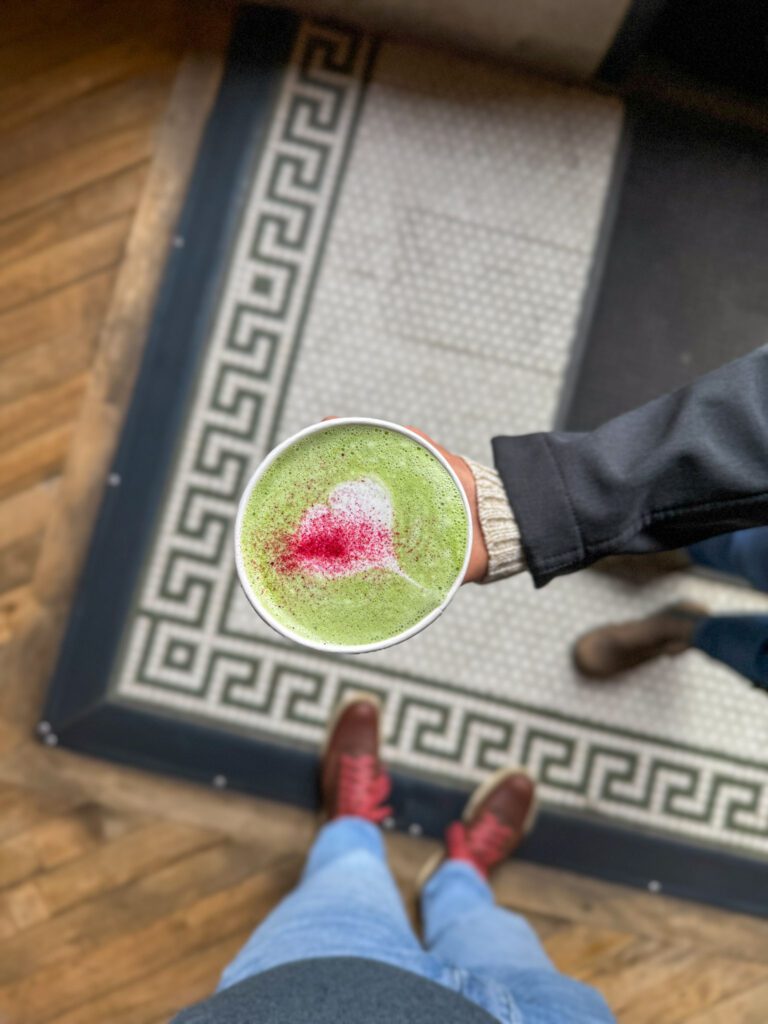
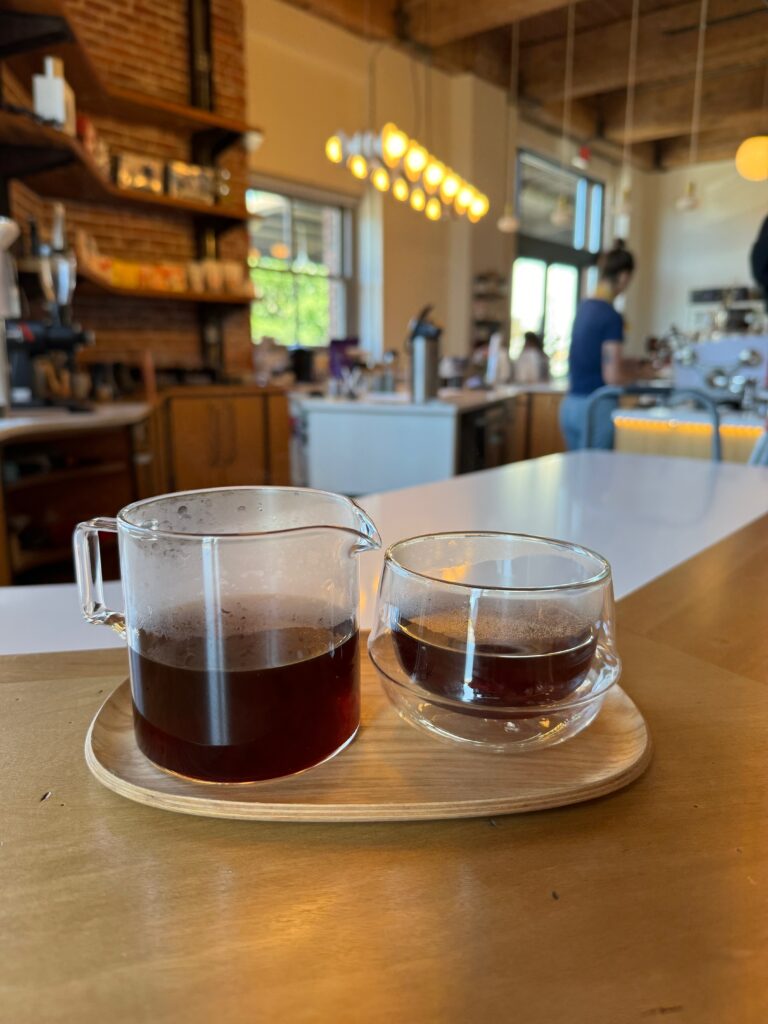
We All Scream for Ice Cream
Ice cream is Alysha’s dessert of choice, and Portland has some really solid ice cream spots that are perfect for a post-dinner stroll on a warm summer evening.
First, a special shout out for Salt and Straw, which has a location on NW 23rd that we’ve been to. Salt & Straw is no longer a hip little chain confined to the Portland city limits – they now have locations all over the west coast (and Miami, of all places).
However, that doesn’t mean their ice cream isn’t delicious.
The innovative seasonal flavors are where Salt & Straw really shines, and we’d implore you to at least try them when you’re here.
In particular, the berry seasonals in the summertime (Oregon and the broader Pacific Northwest are known for incredible berries) are spectacular. I LOVE the Marionberry Habanero.
Second is Fifty Licks, which has a few locations around the city (including one near us in southeast), and has more of a Portland vibe these days (they were started by a person who moved here to learn how to brew beer, and ended up making ice cream).
Once again, it’s the seasonal concoctions that really shine here – Alysha recently had a matcha mochi ice cream and a caramelized honey ice cream that she loved.
The honey cornbread and mango sticky rice flavors are Matt’s favorite (and they will gladly do an allergy scoop for gluten free folks!).
Last, and certainly not least, is Kate’s Ice Cream, whose original location is up on Mississippi Ave and recently opened a second location on NW 23rd.
Their original location up on Mississippi is within a couple of blocks of where we first lived in Portland, and their 100% gluten free and plant-based ice cream is incredible (they won second place in the dairy free category for the North American Ice Cream Association awards).
We’re fairly certain that if you had us blind taste their plant-based ice cream next to similar flavors full of dairy, we wouldn’t be able to tell the difference.
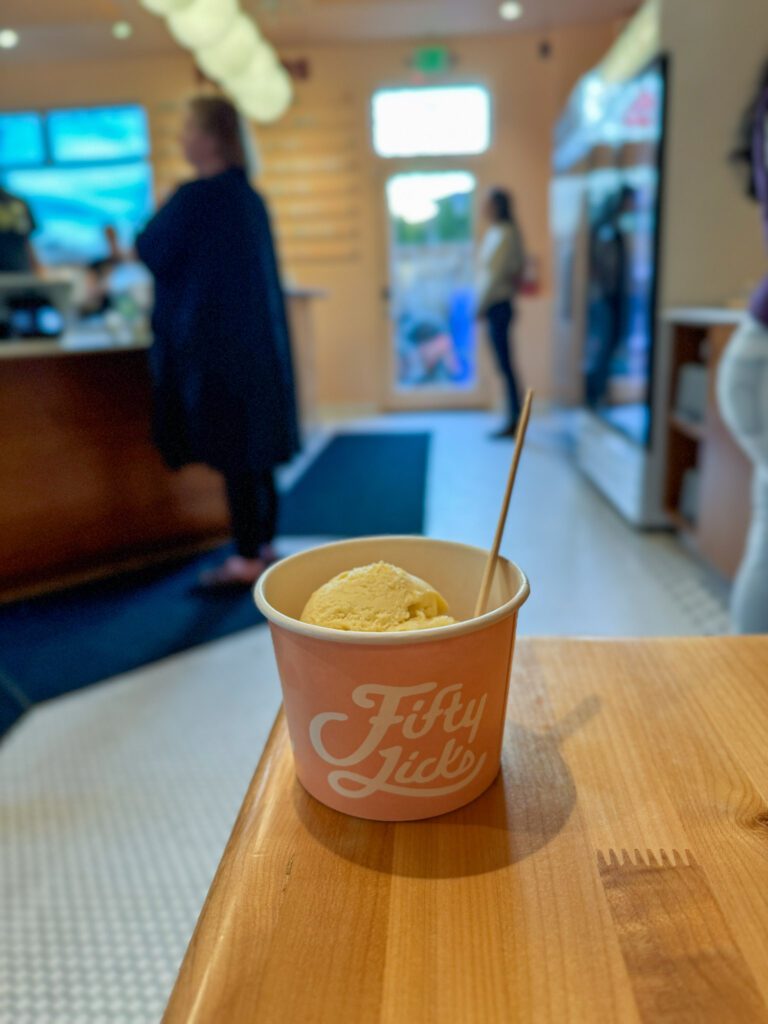
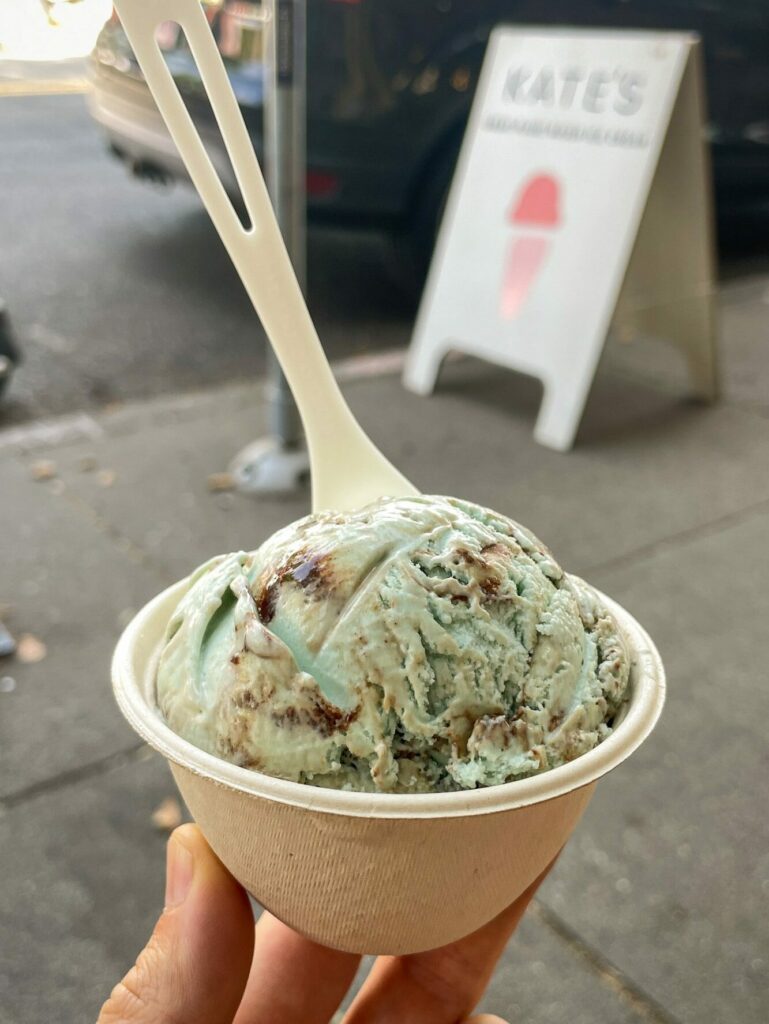
Eat Your Body Weight in Doughnuts
We recently had friends visit from out of town, and it was their first time in Portland.
Of the many things Portland is known for – roses, Powell’s, riots (my tongue is firmly in my cheek here) – the thing they were most excited to explore was the doughnuts.
For whatever reason, Portland has become known for its doughnut scene, which spans the spectrum from affordable old school classics to fancy flavors (and higher prices).
So we have an entire section of this guide dedicated to doughnuts as one of the top things to do in the city.
If you want to spend a few (delicious) hours diving deep into the scene, there’s an entire tour dedicated to exploring a selection of Portland’s donuts, which would be a fun way to try a range of the donuts and connect with a local guide.
Now, there are a TON of different doughnut spots around Portland and the surrounding suburbs, and nearly every Portland resident has a different favorite.
We’re going to cover the staples and our favorites, which is going to inevitably leave out a bunch of other great options.
This guide is already LONG, and we can’t include them all!
What About Voodoo Doughnut?
The first thing we probably need to talk about is Voodoo Doughnut, which is the pink-boxed, quirky flavored doughnut shop that, in many ways, started it all.
It’s also probably the shop that you’ve had recommended to you by a friend who went to Portland once ten years ago and is trying to recall their favorite spots.
Voodoo is both the most popular with tourists and the most maligned of Portland’s doughnut offerings, but we do think it fills a unique niche in the scene here.
That niche being creative, quirky flavors that were emblematic of Portland in the 90’s and 00’s.
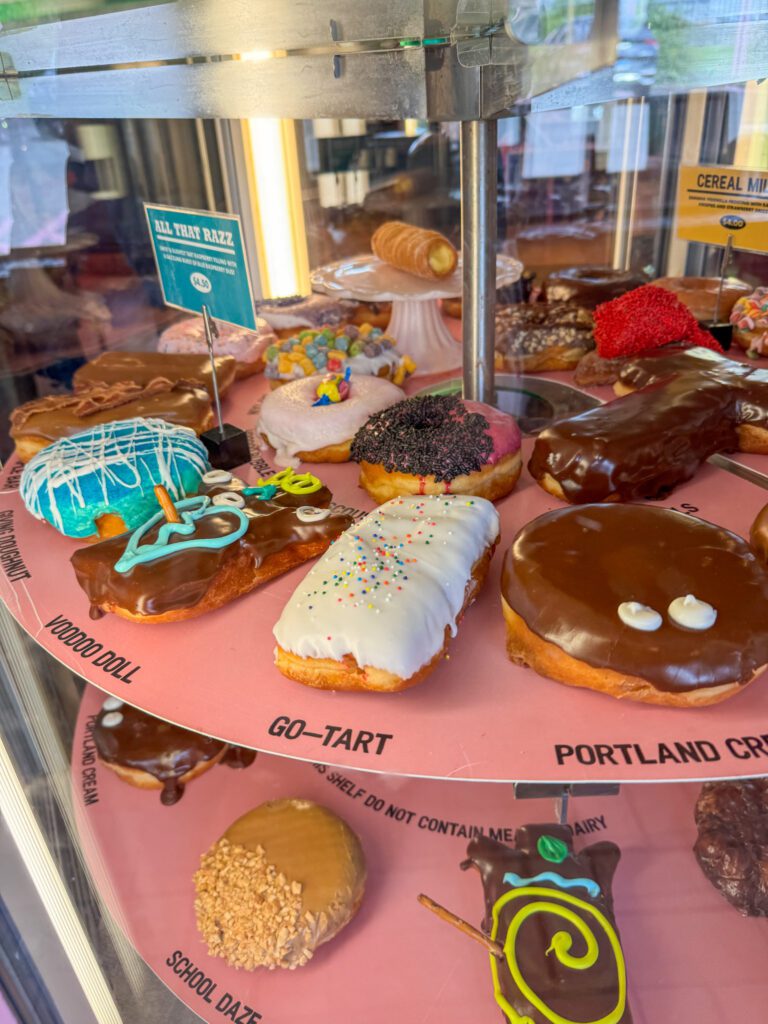
It’s also worth acknowledging that the rest of the doughnut offerings in Portland almost certainly would not have happened – or at least would not be as prolific – without Voodoo leading the way.
Our pick of their funky flavors is the “Oh Captain, my Captain” which is a classic glazed doughnut topped with Captain Crunch (with Crunch Berries *™* of course).
Now, it should definitely be noted that, today, they have a location at Disneyworld…which is almost the dictionary definition of the opposite of Portland’s vibe in the 90’s and 00’s.
There are two things to know about Voodoo going in.
First, the doughnuts are, to quote our doughnut enthusiast friend, “bang-on average” (he also mentioned that he’s eaten a thousand doughnuts just like the one he got at Voodoo in his life).
Which leads me to my second point – we would NOT recommend the Old Town location of Voodoo (the one on the downtown side of the river) because the lines are long, and it’s not a particularly pleasant part of town to spend time waiting in line.
They have another location on Davis on the Eastside (here on Google Maps) that we’d go to instead.
Basically, if you absolutely HAVE to try Voodoo, go for the novelty flavors and go to the Davis location.
We’ll leave you with a quote from our doughnut enthusiast friend that we think just about sums up our feelings about Voodoo:
“I’d be upset if I waited in line for that doughnut.”
Our Favorite Doughnut Offerings in Portland
Now that we’ve addressed the big (performatively quirky) pink elephant in the room that is Voodoo, let’s talk about the places that we definitely recommend for doughnuts in Portland.
Keep in mind that there really isn’t a “best” here – the places we’ve included here all fill a particular niche or do something fun and different. Which one (or ones) you choose to visit is going to depend on you and your tastes.
Pip’s Original Doughnuts & Chai: This is our favorite place, but it’s a bit far out for most tourists and usually has a line if you come in the morning on a weekend. We like it because it’s the most fun way to eat doughnuts!
Their whole thing is fried-to-order bite size mini doughnuts, and they have a few perpetual flavors (like honey sea salt, the GOAT) and a rotating flavor or two that change with the season.
They also have excellent chai, though the flavors are a little more unique than your typical chai (which isn’t a bad thing at all, but is something to know).
Blue Star Donuts: As controversial donuts in Portland go, Blue Star is a clear second after Voodoo. They are another example (along with Voodoo and Salt and Straw) of local Portland businesses that have expanded to other areas around the country (in this case, L.A.).
Most of the complaining about Blue Star is around the price, which is in a different tier than most other places in Portland at $5-$6 a pop.
However, it is absolutely worth noting that a friend who did the doughnut crawl with us recently chose Blue Star as the “best” of the places he experienced.
In this case, we think you’re probably getting what you pay for here – better ingredients and more creative, food-forward flavors.
Petunia’s Pies and Pastries: Petunia’s is on this list because Matt has Celiac Disease and needs to eat strictly gluten free.
In his opinion, the best gluten free option in the city is Petunia’s.
They’re fried – not baked – and they’re also vegan (though you’d never be able to tell). They have a location downtown a few blocks from Powell’s, but they only do donuts on weekends.
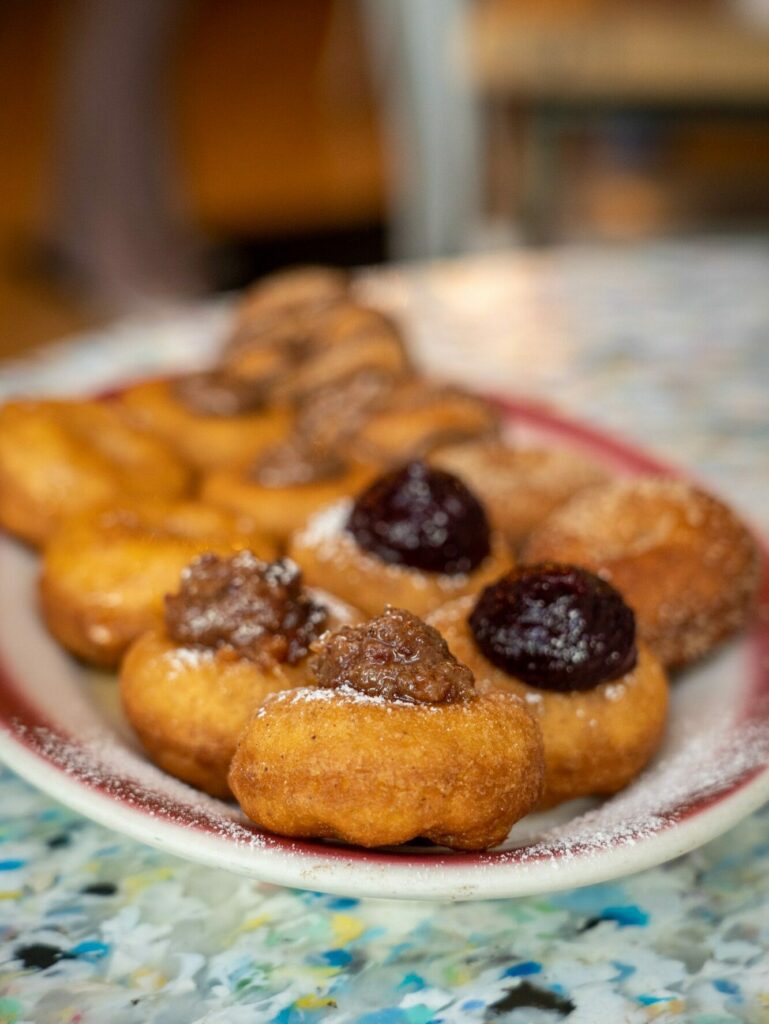
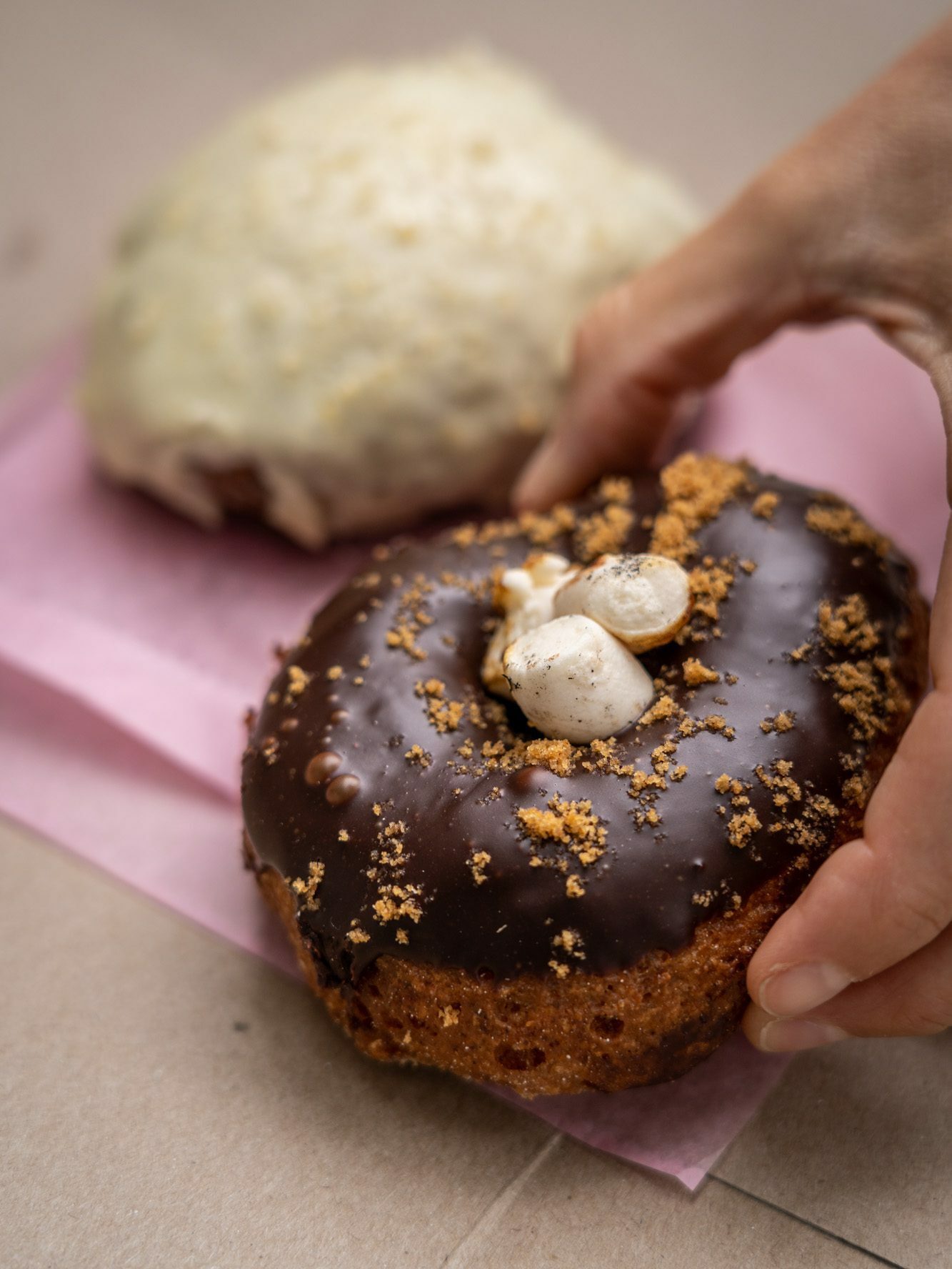
Shop the Bounty at the PSU Farmers Market
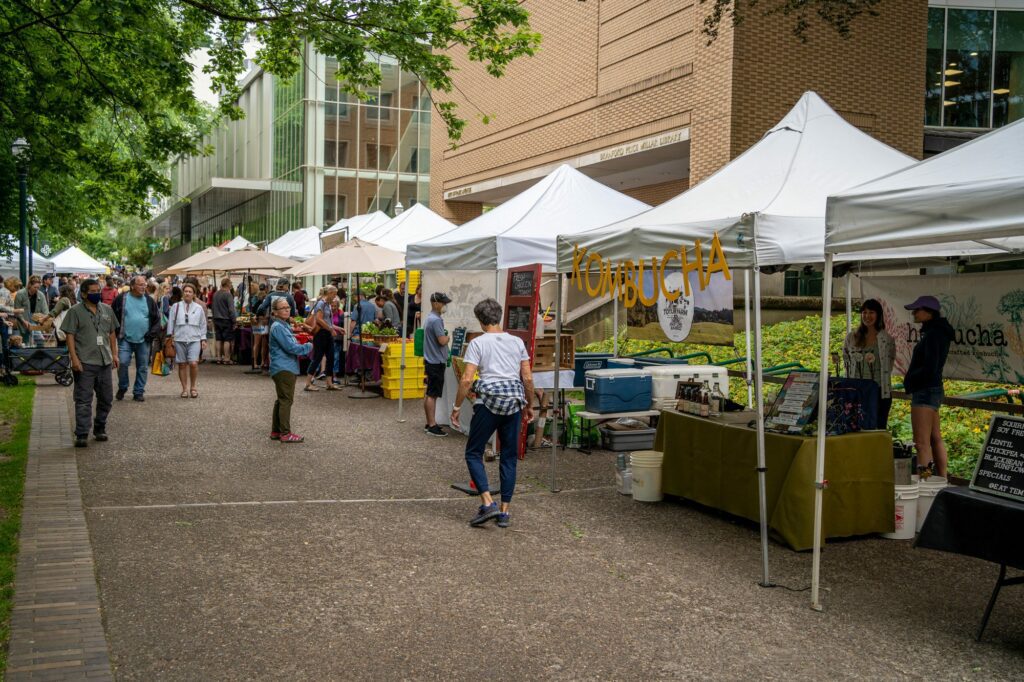
I’ve been saying it for years, well before we actually lived in Portland – the PSU Farmers Market is THE most impressive farmers market I’ve personally ever been to.
It’s several city blocks worth of made-to-order food stalls, produce stands, and various other bakeries, beverage makers, chili oil purveyors, and so, so much more.
This foodie paradise takes place every Saturday morning, rain or shine, in downtown Portland, just south of Pioneer Courthouse Square on the PSU Campus.
The array of food stalls here is also a big draw, with people lining up 40-50 deep to get their hands on a New Mexico-style breakfast burrito, or a cup of coffee made with an old school espresso machine over an open flame.
Here are some stands that we like and find ourselves visiting time and time again.
Three Sisters Nixtamal: Amazing fresh corn tortillas that are the closest we’ve found to being as good as tortillas we’ve had in Mexico.
Hot Mama Salsa: Their coffee chili oil is incredible. We put it on everything.
Draper Girls Country Farm: Our favorite fruit stop near Hood River has a stand here! Good cider, too.
Eloisa Organic Farm: This is our favorite of the many, many produce stands at the market.
Seek Out the Best Views in Portland
There are endless places to get a nice view in Portland, especially from the hills west of the city, and we’ve already covered some of them.
Here are a few more spots in Portland where you can get some excellent views out over the city.
Pittock Mansion
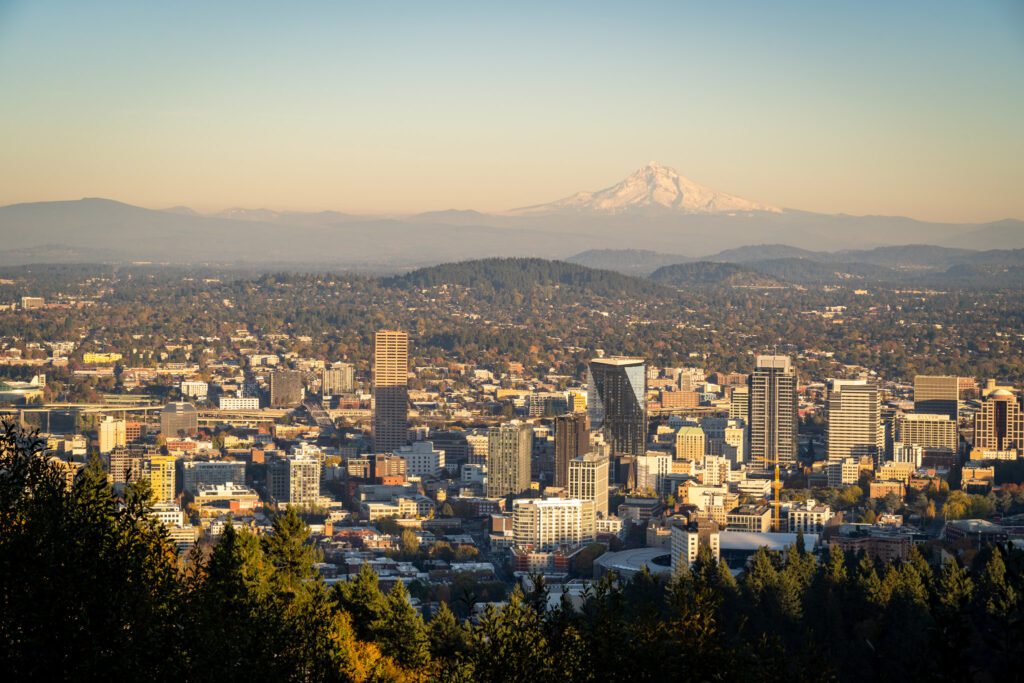
We already included the hike up to Pittock Mansion earlier in this guide, but even if you’re not up for hiking, the view from Pittock Mansion is worth the drive to reach it.
From the grounds, you have a sweeping view out over downtown Portland, including Big Pink (the big shiny pink office building in the middle of downtown) and Providence Park, with the bridges, river, and Mount Hood towering in the distance.
The best time to be here is the afternoon or sunset – in the morning, you’re looking straight east into the sun.
You can find it here on Google Maps.
Rocky Butte
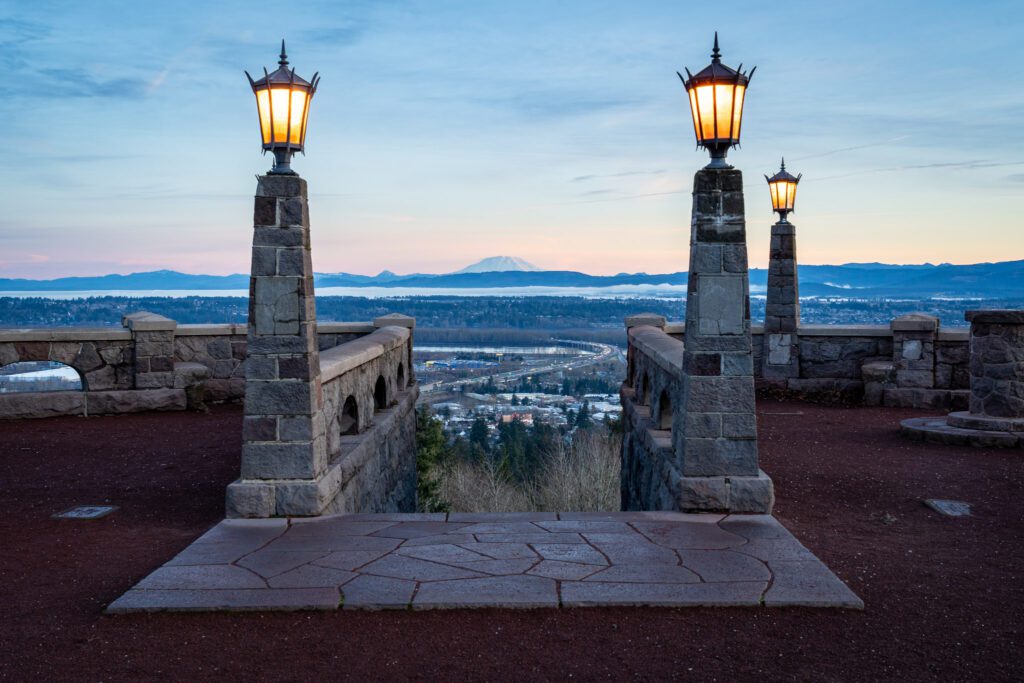
Rocky Butte is yet another cinder cone within Portland’s city limits (Mount Tabor being the most famous). It’s a little bit of a detour from the city center, and is really only accessible if you have a car, but it might be our favorite view in the city. It’s certainly in the top three.
We should say that it’s probably only worth coming out here if it’s clear and sunny, because the main attraction is the collection of mountain peaks you can see from the top.
Right in front of you is Mount St. Helens, with Mount Hood also making an appearance off to the east.
It’s a great view, and is worth visiting at sunrise or sunset to see the peaks light up with that classic pink alpenglow that coincides with the sun moving above or below the horizon.
You can find it here on Google Maps.
Powell Butte
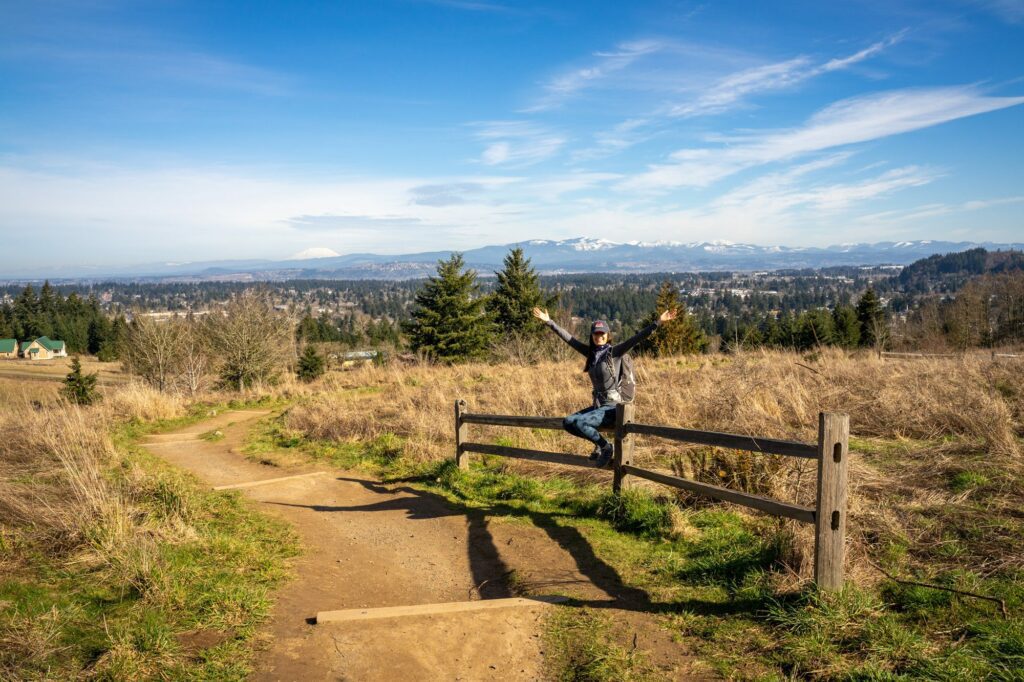
On a clear day, Powell Butte offers a great view of all of the snow capped peaks surrounding Portland, including Mount St. Helens to the north and Mount Hood to the east.
It’s several miles east of the city center, so you won’t have any views of the city itself, but you will have some nice mountain views.
There are a couple of good, relatively easy loops to tackle, and this is the one we usually do with the dog when we head out here.
The Top of the Aerial Tram
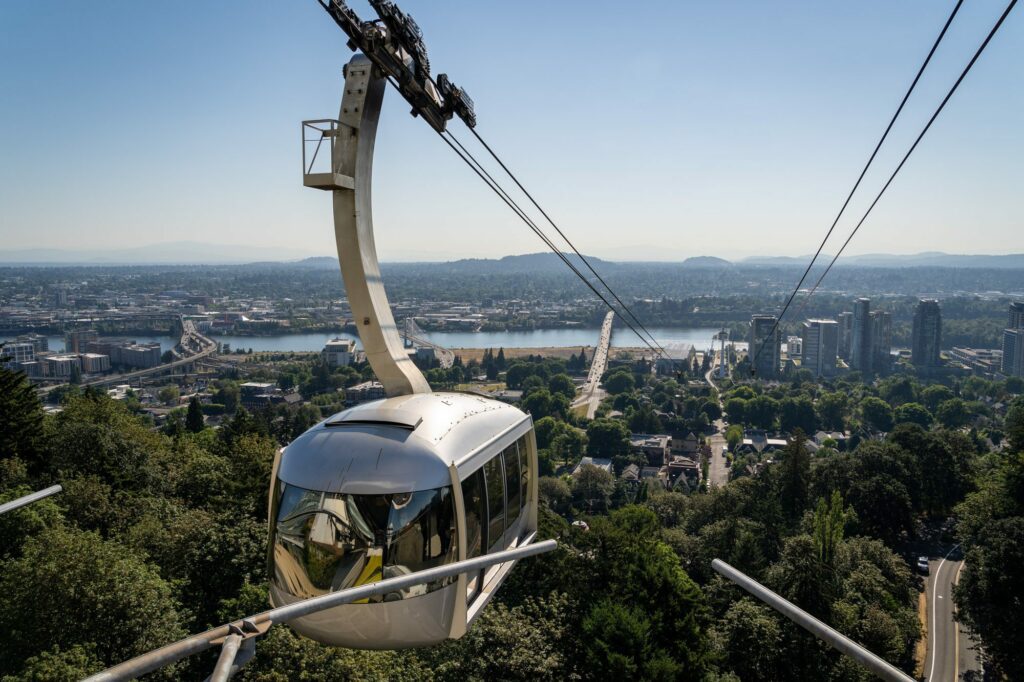
One of the unique aspects of Portland’s public (ish) transit options is the Portland Aerial Tram, which runs from the waterfront up the hill to the OHSU campus to make it easier for employees by making it so they don’t have to drive up the windy roads to get up the hill (plus, it connects with other forms of public transit at the bottom of the hill).
It’s a cool solution to the problem of trying to get thousands of people up to the campus, and is an example of how Portland’s creativity can come through government (more of this, please!).
It’s basically a gondola, and the view from the top is excellent, featuring Mount Hood towering over the eastern half of the city. Once again, you’re looking east from here, so the afternoon and evening is the best time to go.
You can find the lower station here on Google Maps. It costs $8.50 to ride it round trip.
